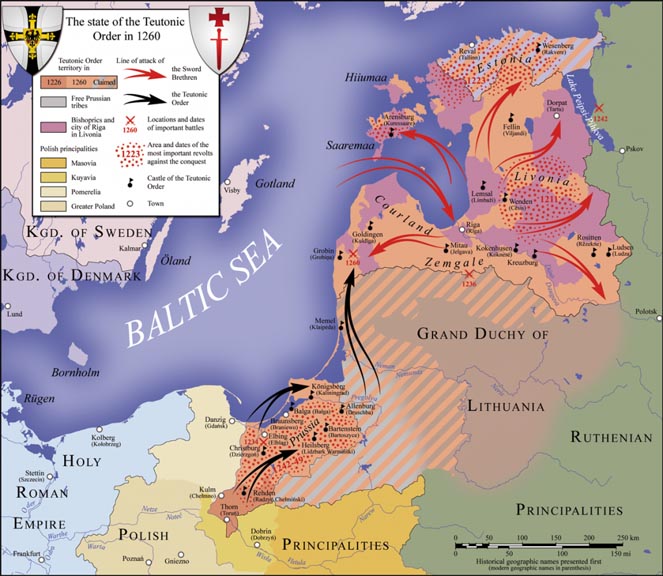[Click this line to jump directly to the BALTIC/NORTHERN CRUSADE]
[Click this line to jump to images of Cathar crusaders and defenders]
From http://atheism.about.com/library/FAQs/christian/blchron_xian_crusades08.htm
Cathar (Albigensian) & Baltic Crusades 1208 - 1300
Although Muslims obviously suffered at the hands of good Christians throughout the Middle Ages, it should not be forgotten that pagans and other Christians suffered just as much. Augustine's exhortation to compel entry into the church was used with great zeal when church leaders dealt with Christians who dared to follow a different sort of religious path. Pagans in the north were targeted for forced conversion.
| 1208 - 1229 | A Crusade against the Cathars (Albigenses) in southern France is launched by Pope lnnocent III. |
| 1208 | Albert, the third Bishop of Buxtehude (Uexküll), makes strong advances in the Baltic Crusade by forcibly converting the Kur and Lett peoples to Christianity. Albert and the Swordbrothers make great use of the fact that most of the tribes in the region are not on good terms with each other. The most effective means for advancing Christianity is to conquer one group, which would not be aided by anyone else, and then convince them to launch an attack on a neighbor whom they already disliked. In this manner one tribe after another was absorbed into Christendom. |
| January 1208 | Pierre de Castelnau, a papal legate in southern France who had been making some progress in converting Cathar heretics (also known as Albigensians) to orthodox Catholicism, is murdered. This sparks an outcry and, later this same year, a violent Crusade against the Cathars and the Waldenses in Southern France called by Pope Innocent III. |
| June 1209 | Raymond VI of Toulouse agrees to the demands of Pope Innocent III that he act against the Cathars after finding that more than 10,000 Crusaders had gathered at Lyon to lay waste to Cathar areas in southern France. |
| July 22, 1209 | The city of Beziers in southern France is sacked and its population of around 10,000 massacred by the Abbot of Citeaux during the Crusade against the Cathars. Caesar of Heisterbach, the papal representative, records Abbot Arnaud-Amaury saying "Caedite eos! Novit enim Dominus qui sunt eius" (Latin for "Slay them all! God will know his own.") |
| August 01, 1209 | Crusaders arrive at the French town of Carcassonne, controlled by Raymond-Roger de Trencavel and believed to be a Cathar stronghold. |
| August 07, 1209 | During the Crusader siege of Carcassonne the city's access to water is cut off. Raymond-Roger de Trencavel attempts to negotiate but is taken prisoner while under a flag of truce. |
| August 15, 1209 | The city of Carcassonne surrenders to the Crusaders. Unlike at Beziers the citizens are not killed but they are all forced to leave. Raymond-Roger de Trencavel is executed and Simon de Montfort, commander of the Crusader army, assumes control of the city and surrounding region for himself. |
| December 1209 | Crusaders attack the castle of Cabaret, near the French town of Lastours. Pierre-Roger de Cabarat manages to hold out, however. |
| March 1210 | Crusaders in southern France lay siege to Bram and, after capturing it, kill the Cathars living there. |
| July 22, 1210 | Citizens of the fortified town of Minerve in southern France surrender to the Crusaders seeking out Cathars. Those who were willing to convert were allowed to do so but the 140 who refused were burned at the stake. |
| August 1210 | Crusaders in southern France trying to root out the Cathar movement lay siege to the town of Termes. |
| December 1210 | The town of Termes falls to the Crusaders after a siege that had lasted since August. |
| 1211 | Crusading Bishop Albert lays the cornerstone for Riga's Dome Cathedral. By this point much of modern-day Latvia had been converted to Christianity and German merchants are settling throughout the region. |
| March 1211 | Crusaders return to the castle of Cabaret and this time Pierre-Roger de Cabarat surrenders. |
| May 1211 | Crusaders capture the castle of Aimery de Montréal, hanging several knights and burning several hundred Cathars who had fought there. |
| June 1211 | Crusaders attempt to besiege the city of Toulouse, but they are short of supplies and must withdraw. |
| September 1211 | Raymond of Toulouse leads an attack on Simon de Monfort at Castelnaudary. Monfort is able to escape, but Castelnaudary falls to the Cathars and Raymond goes on to liberate over thirty Cathar towns in the province of Toulouse before his counter-Crusade peters out at Lastours. |
| 1212 | The Children's Crusade is supposedly launched by the 12-year old French boy Stephen de Cloyes. More than 50,000 children are thought to have been sold into slavery, but many historians disbelieve that this Crusade ever occurred. |
| September 12, 1213 | Battle of Muret: Peter II of Aragon, I of Catalonia comes to the aid of the Cathars in Toulouse and Languedoc who are being harassed by Crusaders. Peter is killed and his army flees. |
| 1214 | Raymond of Toulouse is forced to flee to England. |
| November 1214 | Simon de Montfort entered Périgord captures the Cathar castles of Domme and Montfort. |
| 1215 | The Magna Carta is signed and English barons forced King John to agree to a statement of their rights. |
| 1215 - 1221 | The Fifth Crusade is launched as an attack on Egypt but it ultimately ends in failure. |
| December 14, 1215 | The Fourth Lateran Council accepts the Constitution Ad Liberandum in order to help fund the Fifth Crusade. |
| April 1216 | Raymond of Toulouse and his son, both Cathar heretics, return to southern France, raise a large force from the various Cathar towns that had been captured by the Crusaders, and begin to strike back. |
| 1217 | The Swordbrothers, a Christian army first organized in 1202, invades the region which today makes up Estonia for the purpose of wiping out local pagan beliefs. |
| September 1217 | Raymond of Toulouse recaptures the city of Toulouse from the Crusaders. |
| December 1217 | Armies of the Fifth Crusade attack Mount Tabor. |
| 1218 | Newgate Prison, London's infamous debtor prison, is completed. |
| 1218 | The Swordbrothers begin their conquest of Estonia. |
| 1219 | Pope Honorius III sends Cardinal Pelagius of Albano to the Holy Land to lead the Fifth Crusade. |
| June 03, 1219 | The French town of Marmande falls to the Crusaders. |
| 1220 | During the Baltic Crusade, Conrad of Masovia drives the pagan Prussians out of Chelmno Land. |
| November 22, 1220 | Pope Honorius III crowns Holy Roman Emperor Frederick in the expectation that Frederick would support the Church and participate in the Fifth Crusade. |
| 1222 | Raymond of Toulouse, defender of the Cathars against the Crusaders, dies and his son Raymond takes over for him. |
| 1223 | Pagans from the island of Saaremaa revolt against new Christian leaders, recapturing most of Estonia. They would lose it all again by the next year. |
| 1224 | Amaury de Montfort, leader of the Crusade against the Cathars, flees Carcassonne. The son of Raymond-Roger de Trencaval returns from exile and reclaims the area. |
| November 1225 | Raymond, son of Raymond of Toulouse, is excommunicated. |
| June 1226 | The Crusade against Cathars in southern France is renewed. |
| 1227 |  Medieval
theologian Thomas
Aquinas is born. Aquinas codified Catholic
theology in works like Summa Theologica, marking the
high point of the medieval scholastic movement. Medieval
theologian Thomas
Aquinas is born. Aquinas codified Catholic
theology in works like Summa Theologica, marking the
high point of the medieval scholastic movement. |
| 1228 - 1229 | The Sixth Crusade is led by Holy Roman Emperor Frederick II of Hohenstaufen, King of Jerusalem through his marriage to Yolanda, daughter of John of Brienne, king of Jerusalem. Frederick had promised to participate in the Fifth Crusade but failed to do so, thus he was under a great deal of pressure to do something substantive this time around. This Crusade would end with a peace treaty granting Christians control of several important holy sites, including Jerusalem. |
| June 28, 1228 | Emperor Frederick II of Hohenstaufen officially (and finally) sets forth on a Crusade. |
| 1229 | The Teutonic Order launches a Crusade to conquer Prussia. |
| 1229 - 1231 | James I of Aragon launches a Crusade in Spain, conquering Valencia and the Balearic Islands. |
| 1229 | Death of Albert, the third Bishop of Buxtehude (Uexküll). Albert had been a major driving force behind the Baltic Crusade. |
| February 18, 1229 | Emperor Frederick II of Hohenstaufen signs a treaty with Sultan Malik Al-Kamil of Egypt and thus acquires controls of Jerusalem. Nazareth, and Bethlehem from Muslim forces. Al-Kamil had been impressed with Frederick's knowledge of Arabic language and culture, leading to a mutual exchange of ideas and respect which allowed the dramatic and unexpected peace treaty to be signed. In exchange, Frederick agrees to support Al-Kamil against his own nephew, al-Nasir. Frederick had been essentially forced to negotiate because at the time he had been excommunicated by Pope Gregory IX and most of the Crusaders in the region (for example, Patriarch Gerald of Lausanne, the Knights Hospitaller, and the Knights Templar) simply failed to obey his commands. Gregory refuses to accept the treaty as valid and doesn't support it. |
| March 18, 1229 | Frederick II crowns himself king of Jerusalem in the Church of the Holy Sepulcher. Conrad IV of Germany had become titular King of Jerusalem the previous year with his father Frederick II as regent. Frederick's wife, Yolanda of Jerusalem and titular Queen of Jerusalem. had died the previous year, so Frederick took the crown for himself. |
| April 12, 1229 | A peace treaty formally ends the Albigensian Crusade in southern France. |
| November 1229 | The Inquisition is established in Toulouse to eliminate the last of the Cathars hiding in the Languedoc region. |
| 1233 | The Inquisition launches a ruthless campaign against the Cathars, burning any that they find and even digging up bodies to burn. |
| 1234 | The Teutonic Knights arrive in the Baltic region to assist in fending off invasions from pagan Prussians. |
| May 12, 1237 | By decree of Pope Gregory IX, the crusading order "The Swordbrothers" is merged into the order,"The Teutonic Knights." Both orders had been heavily involved in Crusades against pagan Prussians; the Swordbrothers, however, had experienced numerous defeats (especially at the Battle of Saule in 1236) and their growing weakness necessitated that they join with the Teutonic Knights. |
| October 1240 | Raymond-Roger de Trencavel is defeated at Carcassonne by Crusaders going after Cathars. |
| April 09, 1241 | Battle of Wahlstatt (Polish: Legnickie Pole): A Crusade against the Mongols is proclaimed after the Teutonic Knights and Henry II the Pious, duke of Poland, are defeated by the Mongols. Mongol leader Batu Khan, son of Ghengis Khan, is only stopped from continuing into the heart of Europe by the news of his father's death, causing him to immediately return home. |
| March 16, 1244 | Montsegur, the largest Cathar stronghold, falls after a nine month siege. |
| 1252 | The Teutonic Knights capture the Lithuanian city of Klaipeda from local pagans. Lithuania would be access to the Baltic Sea until the 20th century. |
| 1253 | Pagan leader Mindaugas of Lithuania agrees to convert to Christianity. |
| 1255 | The Teutonic Knights build their stronghold of Königsberg. |
| May 1255 | The last Cathar stronghold - an isolated fort at Quéribus - is captured. |
| 1260 | Battle of Durbe: Lithuanians defeat the Livonian Teutonic Knights |
| 1263 | Mindaugas, first and only Christian king of Lithuania, is assassinated by his pagan cousin Treniota. |
| 1284 | The Teutonic Knights complete their conquest of Prussia, eliminating the local Prussian population as an independent ethnic group. The Prussians would be assimilated by the Germans, Poles, and Lithuanians while the Prussian name would be adopted by the Germans for themselves. |
| 1309 | The Teutonic Order moves its headquarters to Marienburg, Prussia. |
The Albigensian (Cathar) Crusade
From http://xenophongroup.com/montjoie/albigens.htm
c.f., https://en.wikipedia.org/wiki/Albigensian_Crusade
CATHARISMFrom the eleventh to the thirteenth centuries a religious sect called 'Cathars' spread to parts of Europe. The word 'Cathar' is derived from the Greek 'Katharos' (meaning 'pure'). The German word 'Ketter' (meaning 'heretic') was obviously influenced from the Cathars in southern medieval Europe, as the sect was so perceived by the official Roman Catholic Church at the time. The Cathar sect held an austere belief that renounced worldly pleasures, seeing such as destructive temptations provided by an evil deity (the Devil). It believed that a second, good deity (God) created parfaits ('pure souls') that were being corrupted by the material and the pleasures of the natural world they found themselves in. Those of the Cathars who were recognized as parfaits made up the elite, and relatively small leadership of the sect, that practiced extreme asceticism and did not marry. The parfaits held strong sway over the the much larger following refereed to as croyants ('believers'), who were permitted to have families. However, even these were expected, before they died, to undergo a consolamentum, a form of 'baptism' that transformed a soul back to its pure state. Though they thought of themselves as Christians, the Cathars were very opposed to the authority, teachings and clergy of the Roman Catholic or Greek Orthodox churches.
The Cathars were particularly strong in southern France, in the region known as Languedoc, where the language of Oc was spoken as opposed to the French language used in northern France. The northern French called the Cathars 'Albigensians' because of the strong representation of the belief's adherents in the town of Albi.
POLITICAL STRUCTURE of LANGUEDOC
Languedoc is the name of an historic region in the central southern part of what is modern France. It has no unity other than a shared spoken language called langue d'oc. The language of oc was a corruption of Latin mixed with words of various invaders that passed through. The language in this central southern area of France was closer to the older Latin than the French language spoken in northern France (langue d'oil -- especially north of the Loire), which was tinged with some Germanic influences.
Political boundaries in early medieval Languedoc were mostly defined by association with nearby strong fortresses, which might be a walled town or merely a castle. The feudal system was weaker than in northern France, and the local lords maintained considerable independence. Many towns were controlled by councils. Contributing to fragmented political unity in the region were the incursions of the comtes de Barcelona. This powerful ruling house in Catalonia had been acquiring fiefs to the north of the Pyrenees from the early twelfth century. There were other 'foreign' pressures upon Languedoc. To the west was Aquitaine, its duke was technically a vassal to the king of France, but he was also the king of England. To the east, some territories in Provence were considered properties of the Catholic pope as well as of the Emperor of the Germans.
The most prominent counties in Languedoc were Toulouse, Foix, and Comminges. Of equal prominence were the vicounties of Trencavel. The comte de Toulouse, Raymond IV, was also count of Provence (east of Languedoc). His domain encompassed an area of particular active trade and commerce. The wealthy lords of the counties and vicounties in this area lived well, and they allowed an atmosphere of relatively open mindedness and tolerance of beliefs. The Roman Catholic parishes were not as strong a community focal point as they were in many other parts of France. Jews and Cathars served in many of the courts of the comte de Toulouse and the vicomte de Trencavel, the latter was very open in his support of the Cathars.
CRUSADE CALLED
Pope Innocent III (1198-1216) was concerned with the growing influence of Catharism, and saw that it threatened the authority of the Church. He saw the movement as a heresy that needed to be eliminated, as were Arianism and Manichaenism in earlier times. In 1204, Innocent III tasked Abbot Arnaud-Amaury [Arnold-Amalric], head of the Cistercian Order, to be a special legate to investigate Catharism in Languedoc. The papal legate used the cloister in the monastery of Fontfroide as his main outpost. Some regular clerics were also sent by the pope. One from Spain was Domingo de Guzmán, the future St. Dominic and founder of the Dominican Order. Domingo attempted to apply the Cathar's austere methods in his promotion of orthodox Christanity, and he had some success in converting a few Cathars. The progress was inadequate, and the Church decided to use force to either convert or to eliminate the declared heretic followers of Catharism.
The pope asked Philippe II Auguste, the French king (and a cousin to comte Raymond VI de Toulouse), to take action against high nobles in southern France who permitted Cathars to openly practice their faith. Philippe II did not comply, as he was facing a more direct threat from an alliance of the English king, Flemish nobles and the German Emperor.
In 1206, the pope's legate, Amaury, sent his assistant, another Cistercian monk, Pierre de Castelnau, to Provence to form a league of knights to fight Catharism. Castelnau invited comte Raymond VI of Toulouse to lead this host. Raymond saw no value in such a campaign against this community that was widely spread and well ingrained in his lands. He rejected the "idea of waging war on his own subjects," and Castelnau called for Raymond VI's excommunication. The pope ratified the excommunication of Raymond in May 1207. On 13 January 1208, Raymond met with Pierre de Castelnau at Saint-Gilles, in Provence. The monk and Raymond argued and exchanged threats.
The next morning (14 January), Pierre de Castelnau was assassinated as he was departing the town. His assassin was believed to have been an agent of comte Raymond VI. Pope Innocent III reacted by proclaiming a crusade against the 'sinister race' of Languedoc. His Bull offered indulgences for combatants declared that the heretics' lands were open to be taken. This latter offer enticed many knights from far who needed, or merely sought more land.
One such French knight was Simon IV de Montfort l'Amaury, (1165-1218), who was disinherited from his uncle's estates of Leicester, in England, by king John I in 1207. Simon IV was a minor lord in the Chevreuse Valley (in the modern Seine-et-Oise region) of France. He had departed with in the Fourth Crusade in 1202, but refused to participate in the attack upon Constantinople instead of Jerusalem. The pope's offer of confiscated lands inspired Simon IV de Montfort to go south with many other northern French knights in the crusades against the Cathars.
EVENTS of the FIRST PHASE: SIMON IV de MONTFORT's CONQUEST
1209 June, an 'army' of crusaders gathered in Lyon. The number was probably between 10,000 and 20,000 [some accounts estimate over 100,000]. Besides Simon IV de Montfort, there were the duc de Bourgogne, the counts of Nevers and Saint-Pol, the Seneschal of Anjou, and numerous other noblemen. This host marched south, along the River Rhone towards Provence. They were joined by Arnaud-Amaury, the papal legate who had a titular leadership position as 'spiritual advisor' in the 'holy' campaign.EVENTS of the SECOND PHASE: LANGUEDOC REVOLTS (1215-1225)
Meanwhile, comte Raymond de Toulouse recognized the serious situation developing and sought to be reconciled with The Church. In June, he returned to Saint-Gilles, stood barefoot before Pierre de Castelnau's sepulcher, and pledged to expel Cathars from Toulouse. The pope lifted his excommunication, and Raymond VI tentatively joined the crusade. The crusaders marched to Montpellier, (which, should be noted, was a fief of the King of Aragón).
Raymond-Roger III de Trencavel (age 24/25 and nephew of Raymond VI de Toulouse) realized that the crusaders were heading for his lands. Though he was a Roman Catholic, Roger de Trencavel tolerated particularly strong Cathar concentrations in his viscounties of Carcassonne and Albi. He met with the religious 'commander' of the crusade, Arnaud-Amaury, at Montpellier, to 'surrender to the Church'. However, Amaury refused to receive Roger de Trencavel. Knowing that his lands were to be attacked, Raymond-Roger deTrencavel quickly returned to Carcassonne to organize his defenses.
Servian
Early July 1209, Simon de Montfort captured the hilltop village of Servian, to the east of Béziers, prior to going to Béziers.
Béziers
On 21 July, the crusaders reached Béziers and demanded that the Cathars in the population be handed over. This was refused even by the Roman Catholics of the town. The tradition of Cathar strength in this town went back to 1167, when they murdered their vicomte, Raymond-Roger I de Trencavel, in revenge for one of his knights having killed a Cathar. In return the vicomte's son, Raymond-Roger II, had the town ransacked in 1169. Domingo de Guzmán and Pierre de Castelnau had attempted to confront the population in 1206.
On the afternoon of 22 July, the town launched a sortie which, when forced back into the town, was closely pursued by a band of the crusaders. Once inside the walls of the town, the crusaders seized Béziers within an hour. Immediately there began a mass slaughter of Catholics and Cathars, alike. When asked by one of the crusader warriors about the possible killing of Catholics along with the heretic Cathars, Arnaud-Amaury is supposed to have delivered his nefarious statement "Kill them all! God will recognize His own!" Accounts vary as to the numbered slaughtered (10,000 to 20,000, with just over 200 estimated to have been Cathars) in this, the bloodiest and first, battle of the crusade. The massacre frightened many other towns to surrender without resistance.
Present among the crusaders was a Cistercian monk, Pierre des Vaux-de-Cernay, who ten years later would write his chronical Historia Albigensis of the campaign.
Puysserguier
In autumn of 1209, Guiraud de Pépieux, lord of a small estate between Carcassonne and Minerve, rallied to the crusaders' camp after the fall of Béziers. Later, he revolted and captured Puysserguier castle and took prisoner two of the knights who guraded the fortress. By the time Montfort arrived with aid, Guiraud had departed with his captives for Minerve. Out of revenge, Guiraud mutulated his prisoners (blinding them and cutting off thier noses and upper lips) and sent them naked in the cold to Carcassonne.
Carcassonne
Carcassonne was the next objective of the crusaders. They arrived before the impressive fortifications on 1 August 1209. The town's population was bloated with many Cathars and others who had fled the northern French crusading host. This perceptively impregnable fortified city of 26 [30?] towers sat above the Aude River. Its vunerable point was that it relied on access to the river for its water supply.
Pedro II d'Aragón, a Catholic monarch, who had won considerable fame in fighting the Moors in Spain, was a protector of the Trencavels [and brother-in-law to Raymond VI de Toulouse], came to Carcassonne and tried to mediate. Arnaud-Amaury continued to refuse giving any quarter in the crusade, and Pedro II departed in anger. The siege proceded with the both sides employing trebuchet and mangonel rotating-beam artillery, along with other large siege machinery. However the most effective tactic was the crusaders' capture of two faubourgs outside the walls, the first on 7 August. This effectively cut off the Carassonne defenders' access to the river.
Thirst and spreading disease forced Roger de Trencavel to seek negotiations for surrender. While supposedly under 'safe-conduct', he was made prisoner. Carcassonne surrendered 15 August 1209. Raymond-Roger III de Trencavel died in one of the fortress dungeons on 10 November. Montfort's crusaders did not conduct a massacre, but forced the residents of Carcassonne to to depart the walled city, "taking nothing but their sins." Roger III de Trencavel's wife and young son (Raymond-Roger IV) took refuge with the comte de Foix, whose sister, Esclarmonde, was a Cathar.
Simon de Montfort sought suzerain status over Carcassonne, Albi, Béziers and the Razès area. The other senior French lords of the crusade were not interested in possessing such contentious lands. Most, like the comtes de Nevers and Saint-Pol returned to their northern domains by autumn of 1209. The duc de Bourgogne remained through September at Carcassone with about 300 men. He tried and burned two Cathars in October 1209.
Towns such as Castelnaudary, Fanjeaux, Montréal, Limoux, Castres, Albi or Lombers surrendered without a real fight. Montfort pushed beyond the Trencavel vicomtes and attacked lands of the comte de Foix (Mirepoix, Foix and Saverdun). However, some the towns revolted against Montfort: Castres, Lombers, Montréal, etc. Cathari and 'faidits' (lords who dispossessed of their lands) took refuge in Minerve, Termes or Cabaret and launched counter attacks against what was left of Montfort's army.
In December 1209, de Montfort was recognized by Innocent III as a direct vassal of the Roman Pope.
Lastours-Cabaret
Late in the year, Simon and the duc de Bourgogne attacked Lastours, a city nine miles north of Carcassone, where Pierre-Roger de Cabaret (a vassal of the Trencavel's) harbored many fleeing Cathars. Lastours-Cabaret was a system of four 'castles' [Cabaret being the lord's residence, Lastours the main citadel stucture, the other two being simple towers] close enough to provide cover for one another. It was a formidable stronghold that permited Pierre-Roger de Cabaret to repulsed the attack. In a raid, de Cabaret took captive Montfort's lieutenant (and cousin) Bouchard de Marly, lord of Saissac.
1210 During winter, Arnaud-Amaury took over and was elected archbishop of comte Raymond VI's port city of Narbonne. The costal town became a major entry for crusaders' supplies and additional men. New venturers came from Anjou, Frisia, Lorraine, Bavaris, Gascony, Champagne, Brittany, Flanders, Normandy, Aquitaine, and numerous parts of Europe.
Bram
In March 1210, de Montfort captured Bram in a 3-day siege. He mutulated 100 of his captives and sent them to Pierre-Roger de Cabaret, at Lastours.
Minerve
In June 1210, the crusaders arrived before the impressively positioned (flanked by deep gorges) fortress of Minerve. They brought four siege machines (trebuchets and/or mangonels), which, along with their sizable stone shot, had to be positioned in the mountains surrounding the town. The fortress town was commanded by Guilhem de Minerve. Though he was not a Cathar, he felt compelled to support his lord de Trencavel. The intense bombardment managed to destroy the staircase to the otherwise secure water well. On 27 June, a number of the besieged population made a night sortie and set fire to the machine, which they named 'Malvoisine' and believed had destroyed their well. Thurst forced Minerve to surrender on 22 July. Arnaud-Amaury refused any negotiated terms. Three women of the town agreed to convert and were spared. Reportedly 140 Cathars who refused to abjure their faith died at the stake. This was the first burning at the stake in the crusade.
Termes
In early August, de Montfort began his siege of Termes, whose lord was a devoute Cathar. However, he was hampered by Pierre-Roger de Cabaret raiding his wagon rain. One attack seriously damaged the wooden siege engines. In another attack, Pierre-Roger decimated Montfort's rearguard and mutilated those captured as a response to what Montfort had done to his captives at Bram. The siege lasted until December, when the defenders ran out of water. The Cathar lord was placed in the Carcassonne dungeon, where he eventually died.
1211 Arnaud-Amaury remained relentless in his goal to eradicate the heretics. In January 1211, he accused several prominent citizens of Toulouse as heretics. When Raymond VI refused to prosecute them, he was again excommunicated by Arnaud-Amaury.
Pedro II d'Aragón was present when Arnaud-Amaury presented his ultimatum to Raymond VI, and expressed his resentment of the outragous demands and actions of the crusaders. Raymond VI was encouraged with the Aragón king's support and began to organize a coaltion of neighboring lords (comtes de Foix and de Comminges) who were threatened by the obvious land-grabing of Montfort.
Lastours-Cabaret
With the arrival of a new host of crusaders from northern France in March 1211, Montfort was able to significantly threaten Pierre-Roger de Cabarat's formidable Lastours-Cabaret defense complex. Pierre-Roger agreed to free Bouchard and surrendered his fortresses in exchange for some land in Béziers.
Lavaur
In May, de Montfort attacked and quickly seized Lavaur, the castle of Aimery de Montréal, a lord who had revolted against Montfort. Aimery and his knights were hung and about 300 to 400 Cathars burned. Aimery's sister, Giralda de Laurac, was reportedly turned over to be abused by Montfort's soldiers before being thrown in a well and stoned to death.
During Montfort's attack on Lavaur, the comtes de Foix and Comminges managed to attack a host from Germany that was coming to join the crusaders.
Cassès
This was quickly taken in early June, and about fifty Cathars were burnt.
Montferrand
This small fortress was surrendered by Raymond VI's brother, Beaudouin, who soon after joined the ranks of the crusaders as he turned over the castle, Bruniquel, to Montfort.
Toulouse
In June, Montfort, reinforced with a large contingent from Germany, led the crusaders to besiege Raymon VI's principal town, Toulouse. It was a fromidable walled city and had also been reinforced with warriors from Commings and Foix. Montfort fended of some sorties from the city, but eventually (29 June, after two weeks of siege) had to pull back to replenish his force.
Castelnaudary
In September, Raymond VI de Toulouse and Raymond-Roger de Foix led a sizable force [possibly about 10,000] to besieged Montfort at Castelnaudary. Montfort's forces had again begun to dwindle, as the varied venturers were not finding the crusade to be very rewarding. However, Montfort was served by a hardcore of warriors, and Raymond VI de Toulouse was not the ablest of commanders.
Raymond-Roger de Foix engaged a relief force, led by Bouchard de Marly, heading to Castelnaudary. The encouter was about three miles from the fortress and Montfort abandoned the defense of Castelnaudary to assist the relief party. His arrival managed to turn the tied of the battle and led to a defeat of Raymond-Roger's army. However, Montfort was not strong enough to try and prevent Raymond VI de Toulouse seizure of Castelnaudary. Raymond VI was able to go on and to captured about sixty fortresses or towns held by Montfort's crusaders.
Lastours-Cabarat
In autumn of 1211, Raymond VI tried unsuccessfully to retake Cabaret.
1212 In April, de Montfort was reinforced with another crusading host, which he led in a series of lightening strikes throughout Toulouse.
1213 In September 1213, Pedro II d'Aragón led an army to Toulouse with, and joined forces with Raymond de Toulouse and the comtes de foix and Comminges. It was little over a year after Pedro II had shared the honors in the epic victory over the Almoravid sultan at Las Navas de Tolsa (16 July 1212) in Spain. Pedro II had long resented de Montfort's incursion upon some of his fiefs, and now felt compelled to act against de Montfort's aggression.
Muret
Pedro II besieged Muret, one the castles de Montfort now held. The comtes de Foix and Comminges joined him immediately. Raymond VI was enroute with a large siege train, when Montfort joined his besieged garrison on 11 September.
Pedro II launched an attack on 12 September. It was repelled, and quickly followed by a daring sortie by de Montfort that forced Pedro II's army to engage in a unexpected melée. Pedro II was killed in the action, and his army panicked. De Montfort won a descive victory.
1214 Pope Innocent III appointed a new legate to replace Arnaud-Amaury. The comtes de Foix and Comminges took the opportunity to submit to the new legate in April 1214. Raymond VI was helpless to put any more resistance. He fled to England as the pope proclaimed that Toulouse was proclaimed to be a fief of the king of France, Philippe II, who heretofor had been disinterested in the campaign.
Philippe II's interest changed following his great victories over the English king John I's attempted invasion into southwest France and then over the German Emperor, Otto IV, at the battle of Bouvines (27 July 1214) in northeastern France. This climatic event freed the French monarach to consider acquiring the regions to the south of his principal domain.
Campaign along the Dordogne
In November, 1214 Simon de Montfort advanced to the northern borders of Languedoc and into Périgord, taking some castles along the Dordogne River. The region was a stronghold of Bernard de Casnac, a bold Cathar military leader. Domme castle, a Cathar stronghold was abandoned before de Montfort arrived. Next was Montfort [no relation to Simon de Montfort] castle, which also had been abandoned before de Monftort approached.
Castelnaud and Beynac
Montfort continued along the Dordogne to the impressive fortified castles of Castlenaud and Beynac, each on opposite sides of the river only a short distance apart. De Montfort found Castlenaud empty and placed a garrison in it, as he proceded to Beynac. Beynac was not owned by Bernard de Casnac, nor was it a Cathar position. De Montfort attempted to demolish the fortifications, but did not harm the people, who were under the protection of the king of France. The Dordogne operations marked the northern limits of the Albigensian wars.
1215 King Philippe II sent his son, prince Louis [future Louis VIII] to accompany de Montfort when the latter entered Toulouse in May 1215.
In autumn, at the Fourth Lateran Council, the pope confirmed de Montfort's right to Toulouse. Raymond VII's rights to Provence were not affected, which meant that it remained an inheritance reserved to Raymon VI's eldest son, eighteen-year-old Raymond VII. However, the ten-year-old Raymond Trencaval, son of the deceased Raymond-Roger de Trencaval was disinherited the viscounty Trencaval lands.
Castelnaud
Early in the year, Bernard de Cazenac seized back Castelnaud and killed the garrison de Montfort had left. In October, de Montfort conducted a swift expedition back into Périgord, recapturing the castles and killing all the Cathar defenders. Bernard de Cazenac managed to avoid capture and continued to engage de Montfort.
1216 In April 1216, de Montfort paid homage to Philippe at Paris for his lands, ceding his conquests to the French sovereign. However, resentment rose in the Languedoc region, which welcomed the return of Raymond VI and his 19 year old son, Raymond VII, at the port of Marseilles in April 1216. Many towns rallied to their side. Particularly Avignon, which was within the domain of the comte de Provence and a dependent of the German Emperor. Avignon contributed troops for the capture of Beaucaire, Raymond VII's birthplace in 1197.
BeaucaireEVENTS of the THIRD PHASE:
De Montfort had installed some troops under Lambert de Thury, at Beaucaire, even though the it was in Provence, and outside his rightful lands. Raymond VII besieged the French garrison at Beaucaire in May 1216. His father, Raymond VI, sought reinforcements from Aragon. Simon IV de Montfort rushed to relieve the town. The French crusader garrison held for three months before they ran out of food. After failing in many costly attacks, de Montfort was forced to negotiate the surrender of the castle on conditions that the defenders could leave. It was de Montfort's first major defeat.
Immediately after this reverse, de Montfort rushed to put down another revolt at his capital city of Toulouse. Following this, he went to fight in Bigorre, and met another defeat at Lourdes, at the end of 1216. Lourdes, in the Hautes-Pyrenees, marked the western limit of the Albigensian crusade that pertained directly with the Cathars.
1217 De Montfort proceeded to campaign in the county of Foix. He captured Montgrenier in Feb/March 1217. His campaign reached in to the Corbières area, and as far as the Drôme Valley. Meanwhile, Raymond VII took advantage of Montfort's absence and led a large Aragonese host crossed the Pyrenees and entered Toulouse on 13 September 1217. De Montfort returned and attempted a siege. However, his forces were inadequate and he needed to build a siege train for the town's defense structure remained strong, even though de Montfort had directed it be brought down when he controlled it and had to contend with revolts inside the city.
1218 Toulouse
Starting in spring, de Montfort prepared his siege of Toulouse. In June he brought in a cat, a mobile cover to protect sappers as they approached the wall of the fortress. On 25 June, the defenders disabled the device with their mechanical artillery (rotating-beam trebuchet and/or mangonels firing from within the fortress-city walls) and then sortied out to burn it. De Montfort led a counter attack against the defenders' sortie. During this encounter, Simon de Montfort paused to aid his brother, Guy, who was wounded by crossbow bolt. At that moment, a stone from the defenders' artillery struck Simon de Montfort's head and killed him. The shot was fired by a rotating-beam artillery machine, and reportedly was crewed by women.
The circumstances of de Montfort's death emphasizes the significant role of mechanical artillery in the siege-intensive military operations of these crusades. An explanatory note on the topic can be found at the end of this webpage.
The death of Simon IV de Montfort dramatically changed the nature of the 'crusade'. There was no high noble ready or available to take his place as leader. By default, it remained for the king of France to continue the struggle, which now was not so much to seek and to destroy heretics as to fight for possession of the county of Toulouse.
Raymond VII de Toulouse and the comte de Foix took advantage of the disarray among the crusaders. They defeated an army of northern French knights at Baziège. The new pope, Honorius III (since the death of Innocent III, July 1216) asked the king of France to assist Simon's 26 year-old son and heir, Amaury de Montfort. Philippe II Auguste sent Prince Louis, for a second time. However, Louis' expedition was very circumspect, as his father waited for the confusion in Lauguedoc to settle down.
Belcaire
Belcaire, a refuge for Cathars, was besieged in 1218.
1219 In early 1219, Raymond VII and the comte de Foix defeated a band of crusaders in one of the few open battles of the war, at Baziège.
Marmande
In June, Prince Louis joined with Amaury de Montfort's force, which had been besieging Marmande since December 1218. The town surrendered, and the entire inhabitants [possibly 5,000] were 'massacre' on 3 June 1219.
Louis joined the crusaders to besiege Toulouse on 16 June. However, the prince suddenly withdrew, and returned to northern France in August 1219. Amaury de Montfort continued to suffer a series of defeats, as many of de Montfort's garrisons quickly surrendered to Raymond VII.
1220 Castelnaudary-2
Raymond VII captured Castelnaudary. During the attack, Guy de Montfort (Simon's second son and Amaury's younger brother) was killed. Amaury de Montfort was never able to recaptured the town during an eight-month of siege (July 1220-March 1221).
1221 Montréal
In February, Raymond IV and Roger-Bernard de Foix recaptured Montréal. During the attack, the local lord, Alain de Rouey, who had killed Pedro II of Aragón at the battle of Muret, was mortally wounded.
Montréal was supposed to be where the 'miracle of Fanjeaux' occurred (1207). In an 'ordeal by fire', a Cathar parchment was burnt and St Dominic's parchmant flew up to the rafters and schoched the roof. Fanjeaux is a nearby town where St. Dominic (d.1221), was a priest for a short time. It became a crusader's headquarters, and was attacked and burnt by the comte de Foix.
As Raymond VII and his vassals gradually recaptured their lands, Catharism resurfaced, and many Catholic bishops to fled.
1222 Both Amaury de Montfort and Raymond VII offered sovereignty of the county of Toulouse to Philippe II Auguste, who refused it.
Raymond VI died in July 1222 and was denied a Christian burial by the Church. His son, Raymond VII, who had been the realy dynamic force in the recent campaigns, became the comte de Provence and the disputed land of Toulouse.
Alet
Alet was handed over to comte de Foix by Father Boston.
1223 Roger-Bernard de Foix and Philippe II Auguste of France died. Philippe II's son, Louis VIII initially remained remote from any strong support of Amaury de Montfort.
1224 Carassonne
In January, Amaury de Montfort abandoned Carassonne and retreated to northern France with the remains of his father, Simon IV. He offered the 'conquered lands' to the new French monarch, Louis VIII.
The 18 years old son the of the vicomte Raymond-Roger III de Trencaval (who had died in the Carcassonne dungeon in 1209) returned from exile, and entered his father's former capital city as Raymond-Roger IV de Trencaval. After fourteen years of massacres and people being burnt at the stake, the situation was almost back to where it was 1209. At this point, the crusade had failed. Appropriately for the year 1224, Arnaud-Amaury died, not suprisingly a bitter and disillusioned individual.
Unlike his father (Philippe II), King Louis VIII was ready to expand the Royal domain with the bounty from the Albigensian affair. He accepted the offer of Amaury de Montfort. However, pope Honorius III (who was not eager to have a stronger presence of the French in Languedoc) had to be persuaded by the bishops in southern France to continue supporting a crusade.
CONQUESTS of LOUIS VIII, BLANCHE de CASTILLE, and LOUIS IX (1225-1229)
1225 Raymond VII de Toulouse was excommunicated when he attended the Council of Bourges (November-December of 1225).
1226 In late June, Louis VIII personally led a new crusade into Languedoc. Most of the castles and towns surrendered without resistance. Raymond VII, Roger-Bernard de Foix, Raymond Trencaval and a number of 'faidits' were alone in resisting the Royal campaign.EVENTS of the FINAL PHASE: INQUISITION and the CATHAR's LAST GASPS
Avignon
As a fief of the German Emperor, Avignon, refused to open its gates to the king of France when he came before it on 6 June. After a siege of three months, the city capitulated 12 September 1226. As most all Languedoc submitted, Toulouse prepared to resist alone.
Carcassonne
On 16 June, Carcassonne surrendered to Louis VIII.
Louis VIII became ill, and died in Auvergne on 8 November 1226 as he was returning to northern France. He left his seneschal, Humbert de Beaujeu, to continue the crusade. Blanche de Castille, the regent for her son Louis IX, confirmed Beaujeu's position. Humbert de Beaujeu conducted the crusade until Louis IX was old enough to take over.
1227 Labécède
Labécède was besieged by Humbert de Beaujeu and the bishops of Narbonne and Toulouse. Pounded by siege machines and set afire, the entire town was reportedly massacred.
1228 Guy de Montfort, brother of Simon de Montfort and uncle to Amaury, had returned to Languedoc to defend what was left to the Montfort's claims. He was killed besieging Vareilles in January 1228.
Toulouse was starved in the summer. Bernard and Oliver de Termes surrounded in November 1228.
Blanche de Castile decided to negotiate. She agreed to recognize Raymond VII as the legitimate owner of the county of Toulouse (and vassel of France) if he married his only daughter, Jeanne (then 9 years old), to her son, Alphonse of Poitiers (also 9 years old and brother to the young Louis IX).
1229 In the 'Treaty of Paris', Raymond VII agreed to Blanche's terms on 12 April 1229 at a meeting in Meaux. [The treaty is sometimes given the name of this town.] Raymond VII agreed to fight the Cathar 'heresy', to return all Church properity, to demolish the defenses of Toulouse, and to turn over all his castles, as well as pay damages. Raymond VII was flagelated and humulated on a parvis in front of Notre-Dame, and then imprisoned. His wife was expelled from Toulouse. This marked the end of independence in Languedoc.
More frightening was the establishment of the Inquisition at Toulouse in November 1229. The treaty ended the political part of the crusade, but the religious struggle and the campaign for the Cathar fortresses continued.
1233 Pope Gregory IX supported the Dominican-run Inquisition, allowing it limitless powers to torture and burn heretics at the stake. The institution was established in Languedoc in April 1233. Cathati were ruthlessly sought out. As expected, many resisted and took refuge in castles of viscouny of Fenouillèdes or in Montségur. Sick, eldery, and even exhumed bodies were burned. The Inquisition's gruesome excesses incited revolts that continued for many years in Narbonne, Cordes, Carcassonne, Albi, and Toulouse.
1235 Popular uprisings against the Inquisition occurred in many areas of Languedoc in 1235. The Dominicans were expelled from Toulouse. An inquisitor was thrown into the river Tarn at Albi. At Cordes, the inquisitors were thrown down a 100 foot well to their deaths. By autumn, the inquisitors had been run out of Toulouse, Albi, and Narbonne.EPILOGUE
1240 Raymond-Roger IV de Trencavel led a final revolt. He raised an army and traveled from the Cobières region to win a few victories. He was defeated at Carcassonne on October 1240. Forced to begin negotiations in Montréal [after 34 days of siege], he retired to Aragón with the remnant of his army. The French army, under Jehan de Beaumont, entered the Fenouillèdes. Peyrepertuse, the largest of the Cathar fortresses, surrendered to Beaumont 16 November 1240 after a three-day siege.
1242 Raymond VII de Toulouse tried to clear himself of the insult he had suffered in Meaux. He obtained support from the kings of Castile, Aragón, Navarre, and England. He led an insurrection in May 1242. A small force set out from Montségur to attack and massacre several members of the Inquisition in Avignonet (28 May). Raymond's campaign attempted to take advantage of an invasion by the English king, Henry III, into southwestern France.
Louis IX swiftly defeated the English king Henry III at Saints and at Taillebourg in July 1242. Raymond VII's allies fell away as they saw the French king prepare for a massive campaign into Languedoc.
1243 Again, Raymond VII was compelled to submit to the French king in January 1243. The ceremony took place near Montargis. Though Louis IX pardoned Raymond VII, the Roman Catholic Church did not. Remembering the killings at Avignonet, Raymond VII remained excommunicated.
Montségur
The crusade to wipe out Catharism continued, and the followers were driven to the security of a few strong fortresses. One was Montségur, sitting 400 feet above the surrounding plain [current structure is a reconstruction, built upon the original site]. It had a barbican on a lower plateau to the west . The lord of Montségur and his son-in-law, Pierre-Roger de Mirepoix, held strong Cathar sympathies. They were supported by eleven knights and about 150 soldiers. Including the warriors' families, the fortress contained about 500 people.
In early May, Hugues des Arcis arrived at Montségur with 1,500 men, expecting to starve the defenders out. In November, Hugues des Arcis sent some lightly armed men to scale the precipitous eastern slope. In a daring night ascent, they acquired a foothold and began hoisting up siege machines. They finally began shooting [lobbing] stones upon the barbican to the fortress.
1244 In February 1244, Hugues des Arcis captured the barbican to Montségur. The defenders surrendered at the end of month. The fortress, called by non-Cathars 'Satan's synagogue', was emptied on 16 March, and 210 Cathars were burned in a fire at the base of the mountain.
1249 Eventually, Raymond VII assisted the Inquisition in a further effort to clear his name. He cooperated in the burning of some people at the stake in Agen in 1249. Raymond VII de Toulouse died the same year, as he was preparing to join Louis IX on the Seventh crusade. Jeanne, his daughter, became comtess de Toulouse. When she and her husband (Alphonse de Poitiers) died childless in 1271, the county of Toulouse became part of the Royal domain of France.
1255 Quéribus
The final military action in the epic 45-years' crusade was a siege of the small Cathar fortress of Quéribus. It fell in August of 1255. This remote refuge was never attacked until 1255, when Louis IX requested the seneschal of Carcassonne, Pierre d'Auteuil, to seize it from Chabert de Barberia.
The fall of Quéribus in 1255 marked the last dramatic military operation of the crusades against the Cathars. An earlier date of 1229 is often used, since it marked a 'political' resolution with the Treaty of Paris [also called Treaty of Meaux]. However, there remained a few loose ends.BIBLIOGRAPHY
Raymond VII's daughter, Jeanne, became comtess de Toulouse upon her father's death. She and her husband, Alphonse de Poitiers, died without heirs in 1271. As arranged in the 1229 treaty, Toulouse was annexed to the king of France.
Incidents of Catharism re-surfaced in the fourteenth century. Pierre Authié attempted, but failed, to introduce the belief in Languedoc. Guillaume Bélibaste was reportedly the last known Cathar to have been burned at the stake in 1321. Some may detect traces of sympathy with the Cathar's movement evidenced in the much later, strong receptivity of Protestantism in Languedoc -- if only as a rejection of the Catholic Church's authority. Some bemoan the loss of the distinctive troubadour and relatively tolerant culture of the twelfth-century Languedoc. However, this was probably more affected by the later impact of the Hundred Years' War.
Amaury de Montfort retired to his modest estate in Ile-de-Fance, and went on to serve the king. He was made constable of France in 1230, and joined a crusade to the Levant, where he was captured. He was released after 18 months, and died at Otranto, Italy (1241), as he was returning to France.
His younger brother, Simon, was Simon IV de Montfort l'Amaury's youngest son and also named 'Simon'. The younger Simon de Montfort left France for England, where the king, Henry III, restored Simon (as 'earl') to his ancestral lands in Leicester and married him to his sister. Simon later fell out with the king and sided with the barons in a reform movement. He died fighting the royal forces at the battle of Evesham (1265).
- Aimer le pays cathare
- Jean-Luc Aubarbier. 1992. A 1994 edited version, in idiom from Périgord, is the French text and basis for the following listed work.
- Wonderful Cathar Country
- Jean-Luc Aubarbier, Michel Binet, Jean-Pierre Bouchard; English translation by Angela Moyron. Editions Ouest-France, Rennes, 1994. Profusely illustrated with color photographs and descriptions to guide visits to the various sites as they exist today.
- Le Drame albigeois et le Destin français
- Jacques Madule. Bernard Grasset, Paris, 1961. English translation by Barbara Wall, The Albigensian Crusade (Fordam U., NY, 1967). A fine concise account and analysis of the epic as it related to the development of France. However, it lacks supporting citations.
- The Albigensian Crusade
- Jonathan Sumption. Faber, London, 1978 and 2000. A scholarly, comprehensive, and very readable narrative account in English.
- The Albigensian Crusades
- Joseph R. Strayer. Dial, New York, 1971; re published with an added Epilogue by Carol Lansing that explores aspects of the Cathar 'heresy' (U. of Michigan, 1992).
- Historia Albigensis
- Pierre des Vaux-de-Cerny. Edited by P. Guébin and E. Lyon, 3 vols., 1926-39. A young monk who was eyewitness to much of the crusade until 1219. An English translation, with notes, by W.A. and M.D. Sibly has recently been published: The History of the Albigensian Crusades (Boydell, Suffolk, 1999).
- La Croisade contre les Albigeois 1209-1249
- Pierre Belperron. Librairie Plon, Paris, 1942; and Librairie académique Perrin, 1967.
- Les Cathares
- Arno Borst. Payot, Paris, 1984.
- Le Catharisme: La Historie des Cathares
- Jean Duvernoy. Privat, Toulouse, 1979.
- Les grandes heures cathares
- Dominique Paladilhe. Librairie académique Perrin, 1969. An itinerary through the cathare country.
- The Inquisition : A Political and Military Study of its Establishment
- Hoffmann Nickerson. John Bale, London, 1923 and 1932.
- "Kill Them All... God Will Recognize His Own"
- Douglas Hill. Military History Quarterly, Winter 1997 (9:2) pp.98-108.
- The Yellow Cross, The Story of the Last Cathars 1290-1329
- René Weis. Penguin, London, and Alfred A.Knopf, NY, 2000. A reconstruction and account of the late phase of the Cathar movement. Author employed latest geographical maps, Vatican documents, and a personal visit to the sites to provide a vivid description of what happened to individuals as the Inquisition moved in on a small, remote, community of Cathars that survived in the Pyrenees.
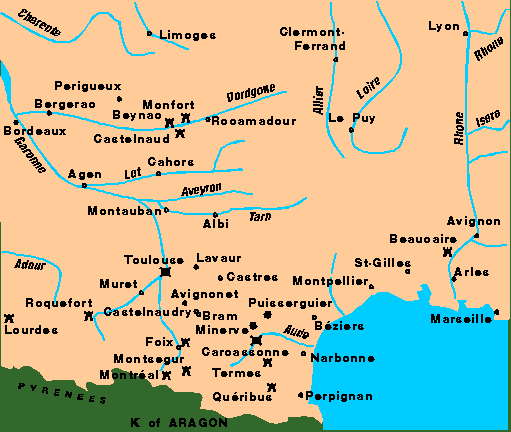
Scene of actions in the Cathar Crusade
The Cathars: Who's Who In The Cathar War
The following are the
chief personalities during the Wars against the Cathars:
Crusaders and Crusade Leaders and Crusader Allies
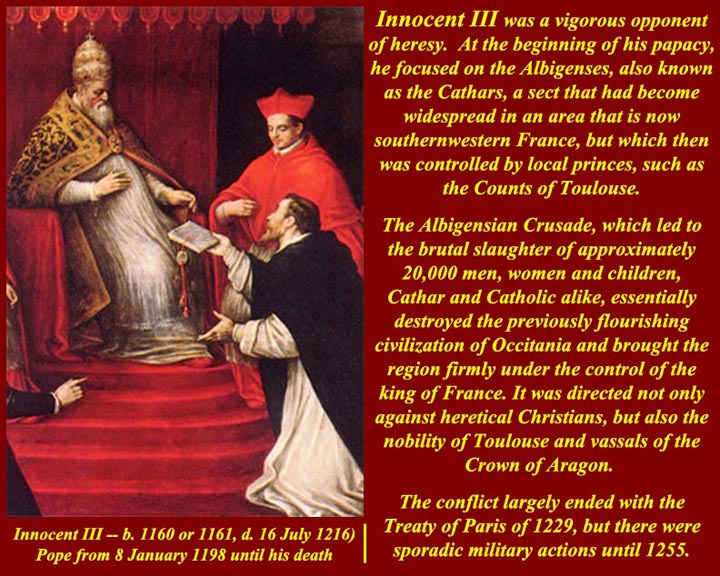
http://www.mmdtkw.org/CRUS0902-Innocentiii.jpg
Pope Innocent III: Called the
crusade in 1208. Click here for more on Pope Innocent
III (http://www.cathar.info/120501_innocent.htm).
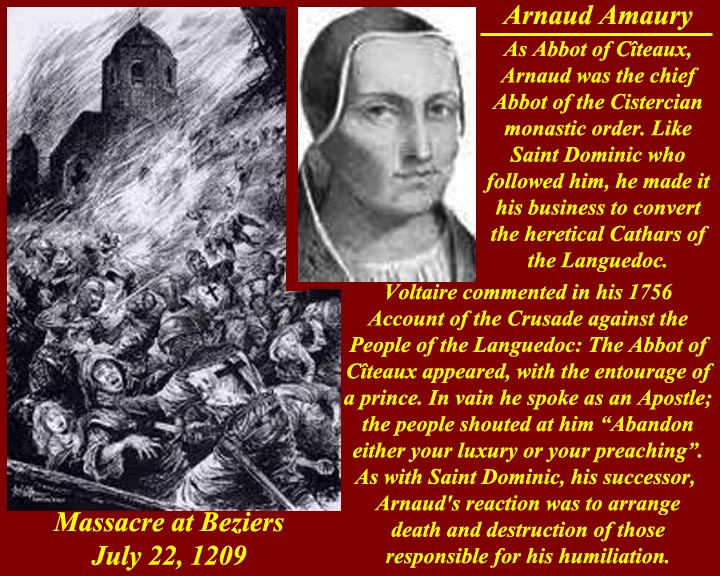
http://www.mmdtkw.org/CRUS0903-ArnaudAnaury.jpg
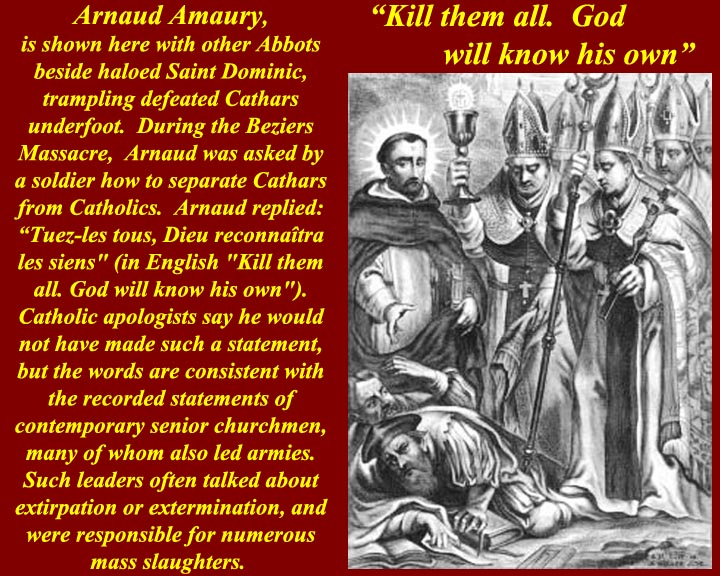
http://www.mmdtkw.org/CRUS0904-ArnaudDominic.jpg
Arnaud Amaury: Cistercian
Abbot of Cîteaux. Military commander of the crusade in
its early stages. Click here for more on Arnaud
Amaury (http://www.cathar.info/120502_arnaud.htm).
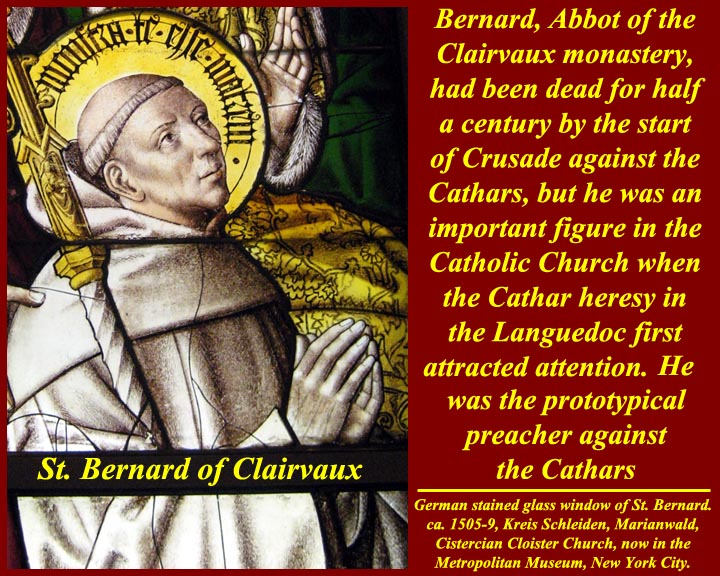
http://www.mmdtkw.org/CRUS0905-BernardOfClairvaux.jpg
Bernard of Clairvaux (Saint Bernard): Cistercian
Abbot who had tried to combat "heresy" in Toulouse and the
Languedoc by preaching against it in the century before the
Crusade. Click here for more on Bernard of
Clairvaux (http://www.cathar.info/120517_bernard.htm).
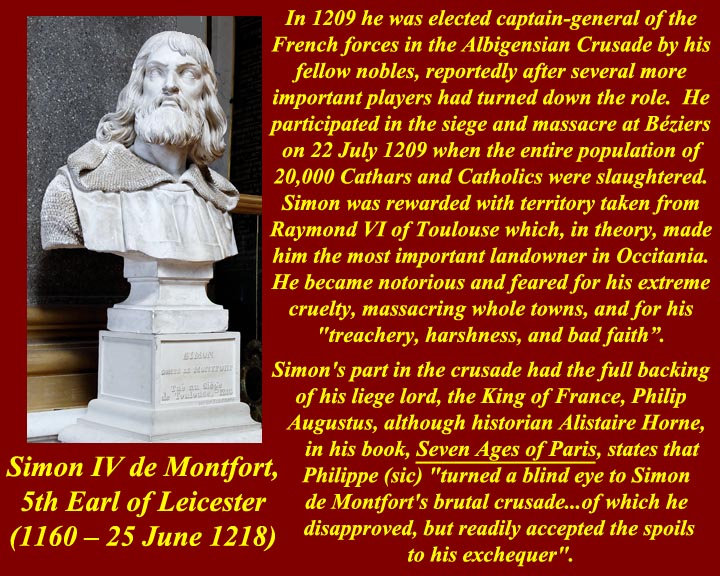
http://www.mmdtkw.org/CRUS0906-SimonIVDeMontfort.jpg
Simon de Montfort: Titular Earl of Leicester, and lord of
Montfort. Took over leadership of the Cathar Crusade
after the initial victories at Béziers
and Carcassonne.
Click here for more on Simon
de Montfort (http://www.cathar.info/120503_simon.htm).
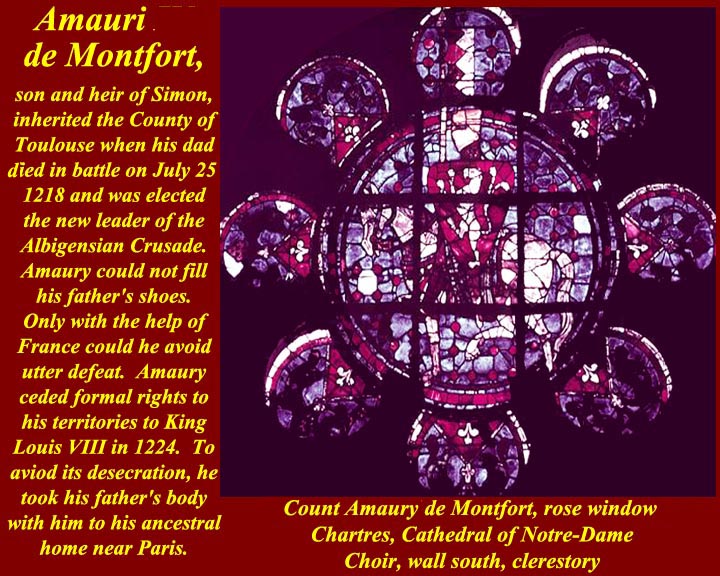
http://www.mmdtkw.org/CRUS0907-AmauriDeMontfort.jpg
Amaury de Montfort: Earl of Leicester. Took over
leadership of the Cathar Crusade after the death of his father
Simon. Click here for more on Amaury de
Montfort (http://www.cathar.info/120503b_simon.htm)
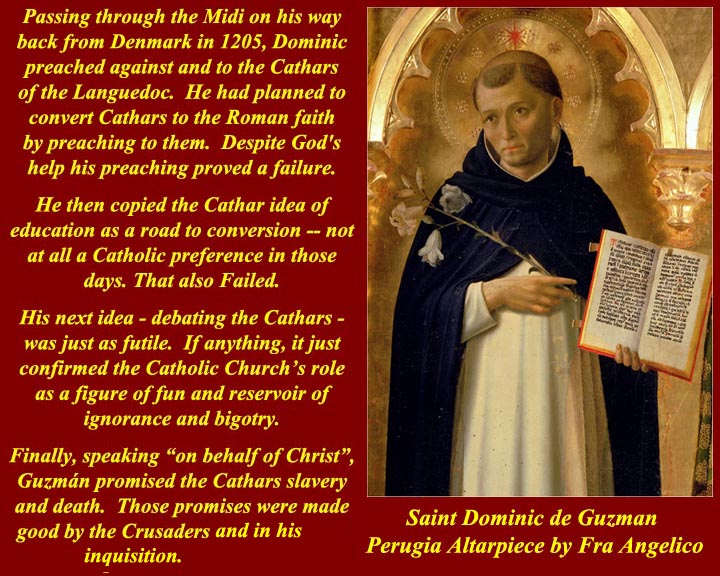
http://www.mmdtkw.org/CRUS0908-DominicGuzman1.jpg
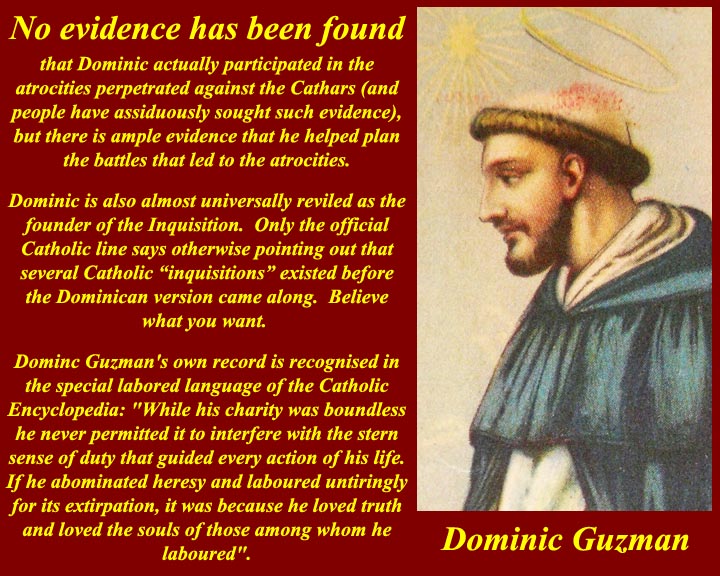
http://www.mmdtkw.org/CRUS0909-DominicGuzman2.jpg
Dominic Guzmán (Saint Dominic): A preacher
who set up the religious order ("The Dominicans") which
established and ran the first
Papal Inquisition. Click here for more on Dominic Guzmán
(http://www.cathar.info/120504_guzman.htm).
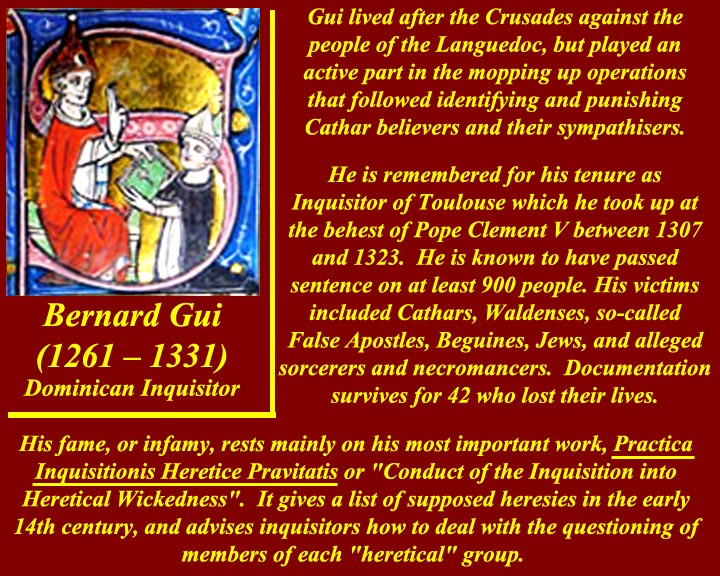
http://www.mmdtkw.org/CRUS0910-BernardGui.jpg
Bernard Gui: A Dominican Inquisitor who left a
useful manual for identifying and punishing Cathars and other
supposed "heretics". Gui, by the way, is depicted
earlier in his life as the villain in Umberto Eco's The
Name of the Rose. Click here for more on Bernard Gui
(http://www.cathar.info/12050401_gui.htm).
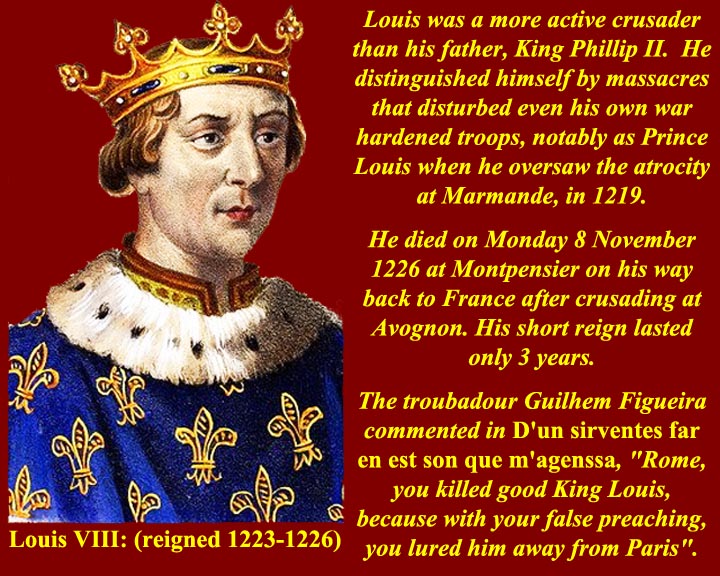
http://www.mmdtkw.org/CRUS0911-KingLouisVIII.jpg
Louis VIII: King of France. Joined the Cathar Crusade
and later led it. Click here for more on Louis VIII
(http://www.cathar.info/120505_blanche.htm).
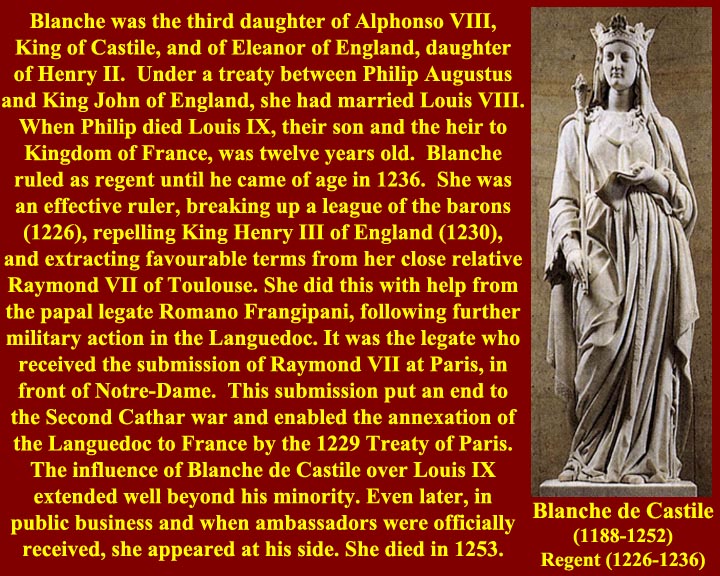
http://www.mmdtkw.org/CRUS0912-BlanchDeCastile.jpg
Blanche de Castile: (1188-1252).
Regent of France (1226-36) during the infancy of her son Louis
IX, King of France. Click here for more on Blanche de
Castile (http://www.cathar.info/120505_blanche.htm).
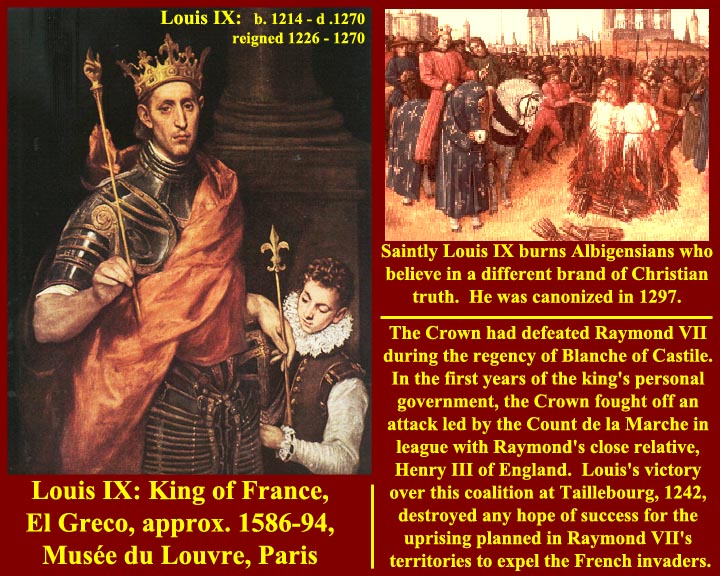
http://www.mmdtkw.org/CRUS0913-LouisIXBurns.jpg
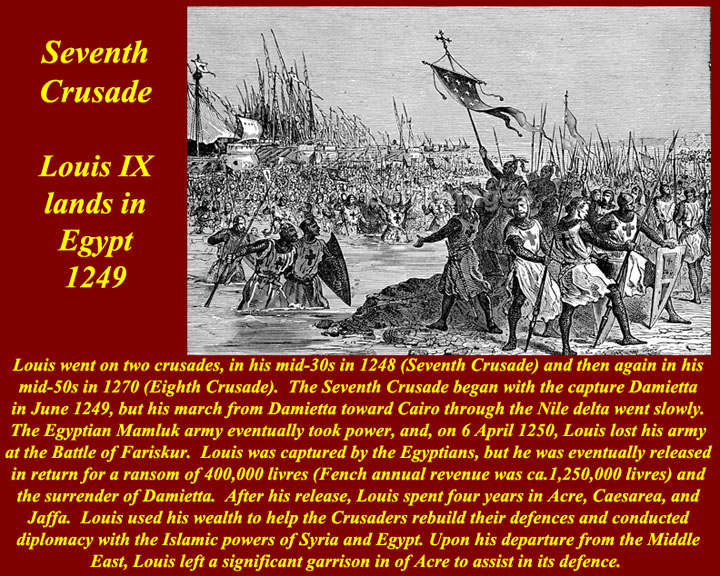
http://www.mmdtkw.org/CRUS0914-LouisIX7thCrusade.jpg
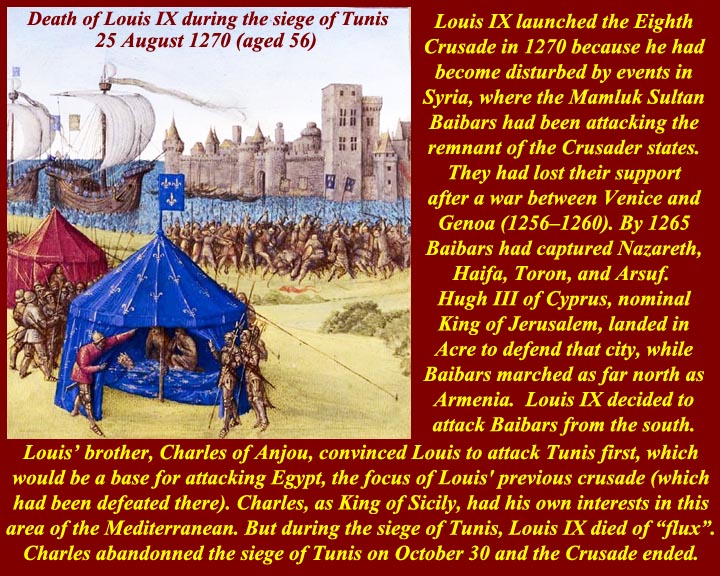
http://www.mmdtkw.org/CRUS0915-LouisIX8thCrusade.jpg
Louis IX: King of
France, also known as Saint Louis, a Crusader King. Click here
for more on Louis
IX (http://www.cathar.info/120505_blanche.htm).
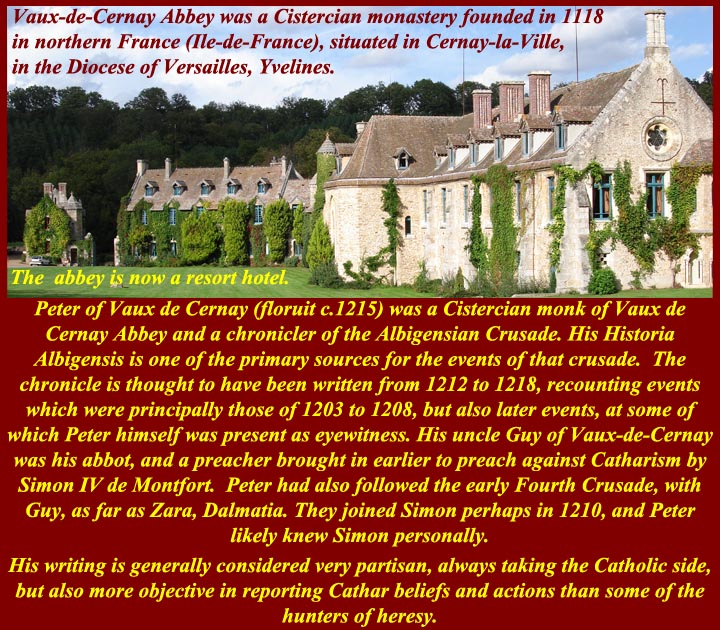
http://www.mmdtkw.org/CRUS0916a-AbbayeDesVauxDeCernay.jpg
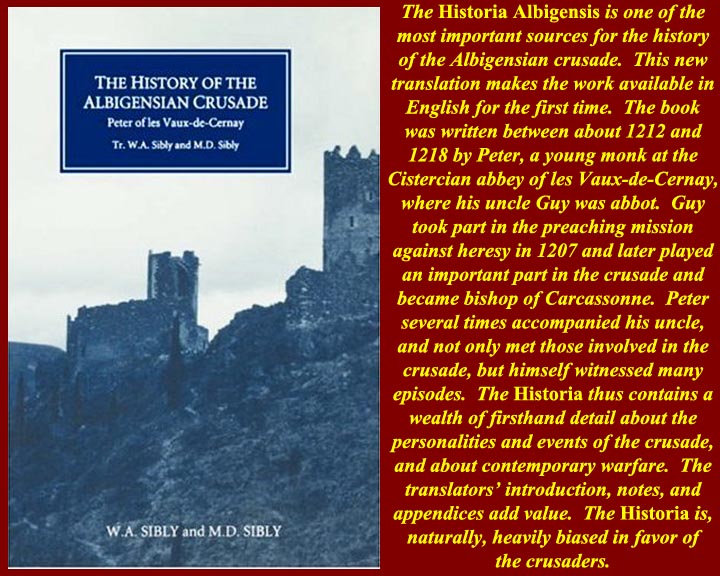
http://www.mmdtkw.org/CRUS0916b-HistoriaAlbigensis.jpg
Guy and Pierre Des Vaux-de-Cernay. A Crusading Cistercian
Abbot (Guy) and his nephew (Peter), a monk who left an
invaluable record of the Crusaders actions and their beliefs.
Click on the following link for more on Pierre
Des Vaux-de-Cernay and his Historia Albigensis
(http://www.cathar.info/121205_historiaalbigensis.htm).
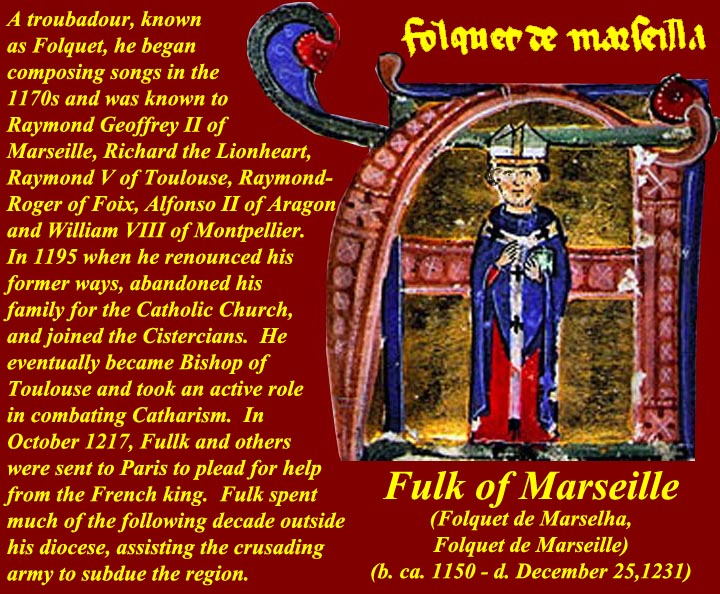
http://www.mmdtkw.org/CRUS0917-FulkOfMarsaile.jpg
Fulk (or Folquet) de Marseille: A troubadour who
later became Bishop of Toulouse. Click here for more on Fulk de
Marsielle
(http://www.mmdtkw.org/CRUS0917-FulkOfMarsaile.jpg).
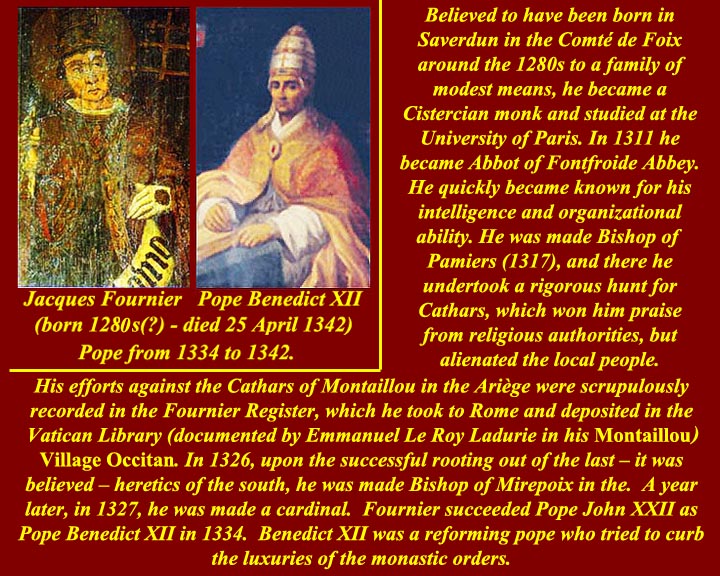
http://www.mmdtkw.org/CRUS0918-JacquesFournier-BenedictXII.jpg
Jacques Fournier, Bishop of Pamiers: (c 1280 - 1342) Famous
for his Inquisition records which survived in the Vatican
Archives after he was elected Pope as Benedict XII. Click here
for more on Jacques Fournier
(http://www.cathar.info/120520_fournier.htm).
Opponents and Victims of the Crusade, and their
Partisans
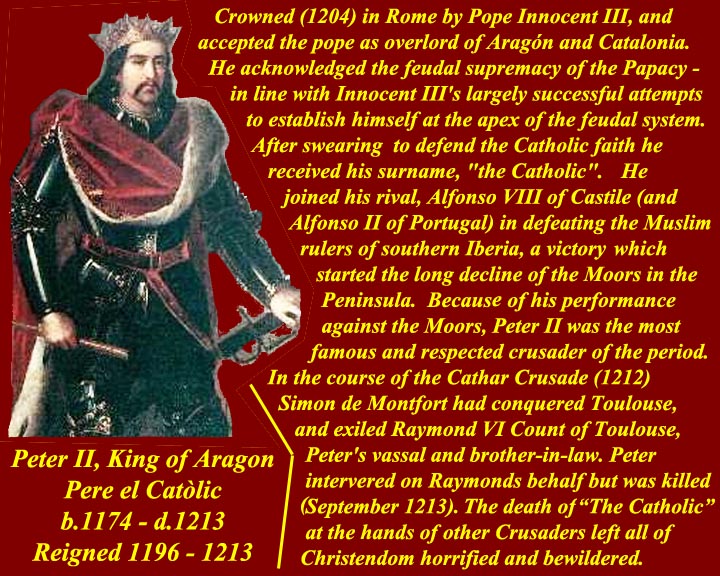
http://www.mmdtkw.org/CRUS0919-PereElCatolic.jpg
Peter II: (1174-1213)
King of Aragon (1196-1213). Close relative and ally of
the Counts of Toulouse. Recognised as the greatest
Crusader in Christendom at the time, but opposed to the
Crusade against his own vassals. Click here for more on Peter II
(http://www.cathar.info/120506_peter_ii.htm).
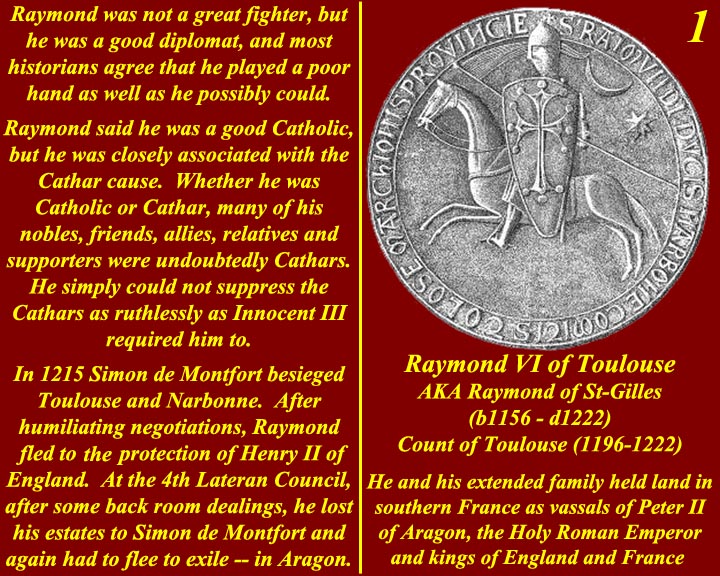
http://www.mmdtkw.org/CRUS0920-Raymond6Toulouse1.jpg
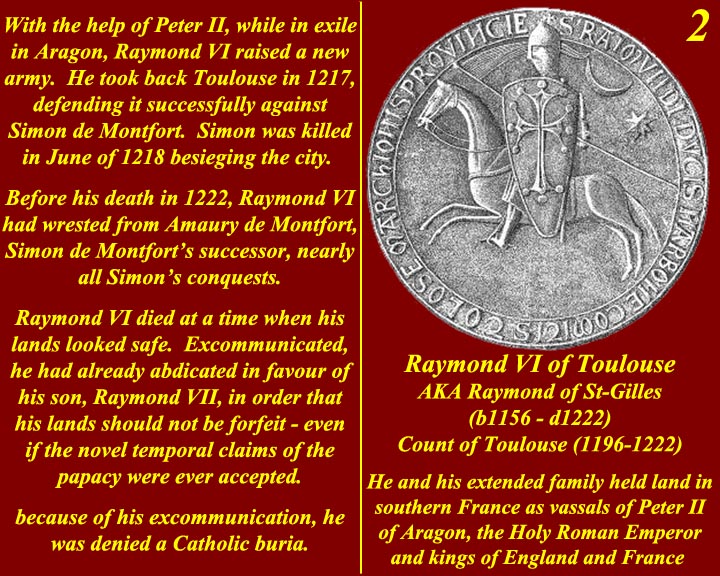
http://www.mmdtkw.org/CRUS0921-Raymond6Toulouse2.jpg
Raymond VI: (1156-1222), Count of
Toulouse (1196-1222). Click here for more on Raymond VI
(http://www.cathar.info/120511_raymond_vi.htm).
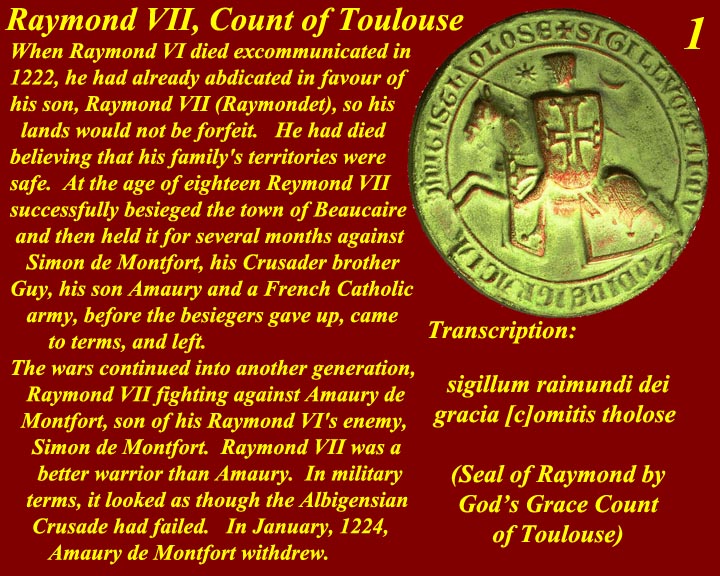
http://www.mmdtkw.org/CRUS0922-Raymond7Toulouse1.jpg
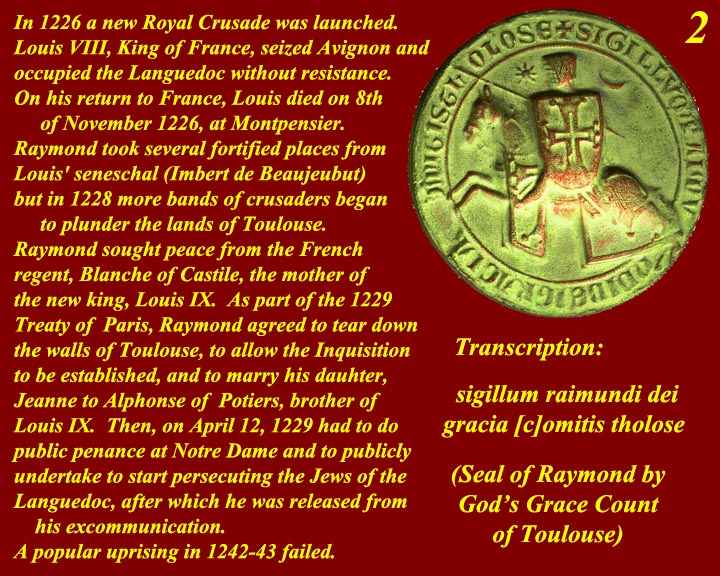
http://www.mmdtkw.org/CRUS0922-Raymond7Toulouse2.jpg
Raymond VII: (1197-1249), Count of Toulouse
(1222-1249). Click here for more on Raymond VII
(http://www.cathar.info/120512_raymond_vii.htm).
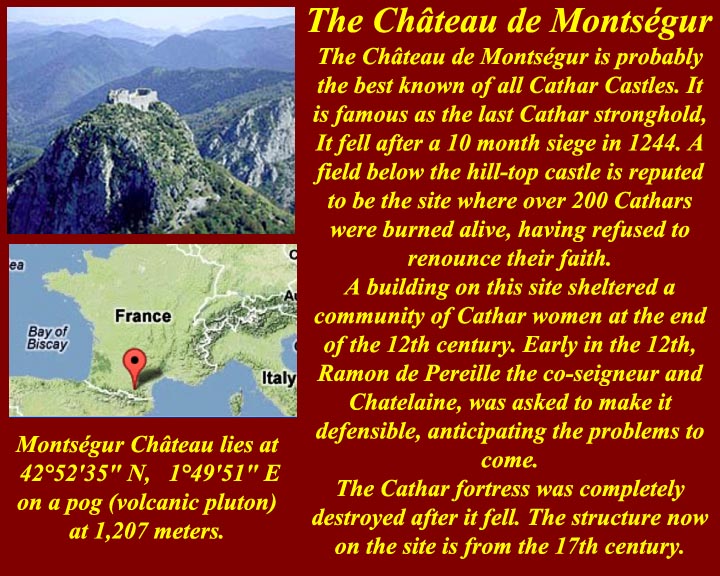 http://www.mmdtkw.org/CRUS0923-MontsegurFortress.jpg 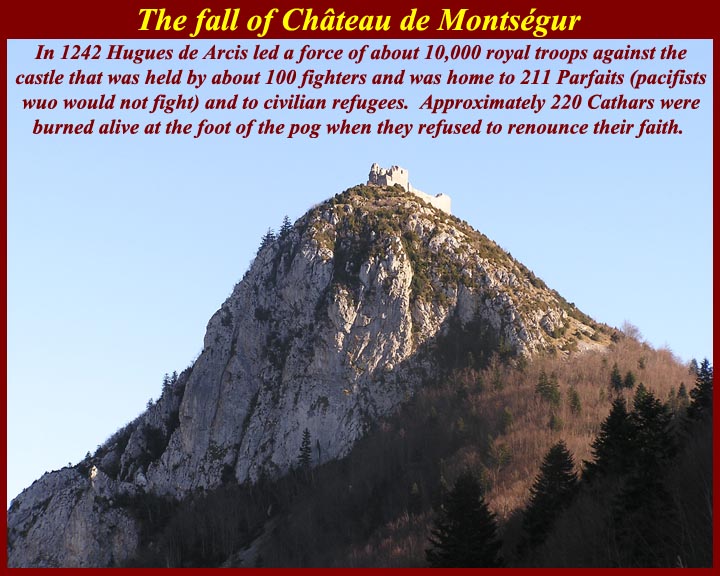 http://www.mmdtkw.org/CRUS0924-MontsegurFall.jpg The last Cathar castle to fall was the apparently impregnable Montsegur fortress. In 1242, it took 10,000 attacking troops ten months to capture the fortress that was defended by 100 Cathar fighters. Click here for more on Montsegur (http://www.catharcastles.info/montsegur.php?key=montsegur). |
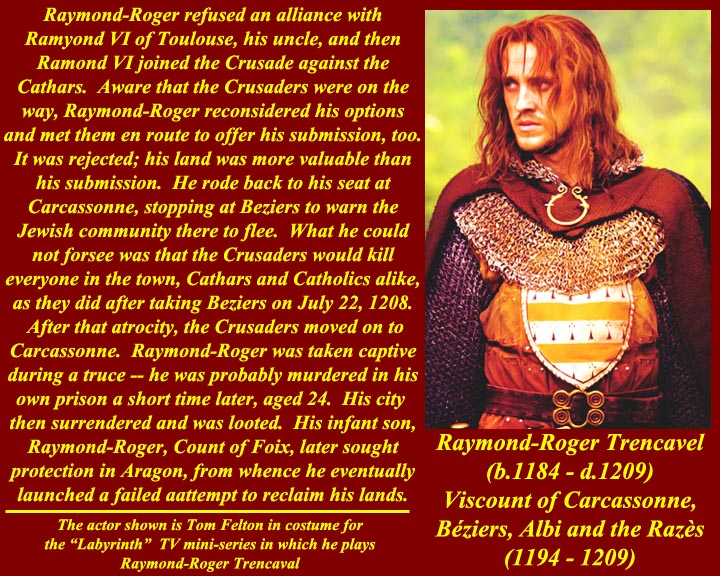
http://www.mmdtkw.org/CRUS0925-RaymondRogeTrencaval.jpg
Raymond-Roger Trencavel: (1184-12093). Viscount of
Carcassonne. Relative of the Counts of Toulouse. Click
here for more on Raymond-Roger
Trencavel
(http://www.cathar.info/120513_trencavel.htm).
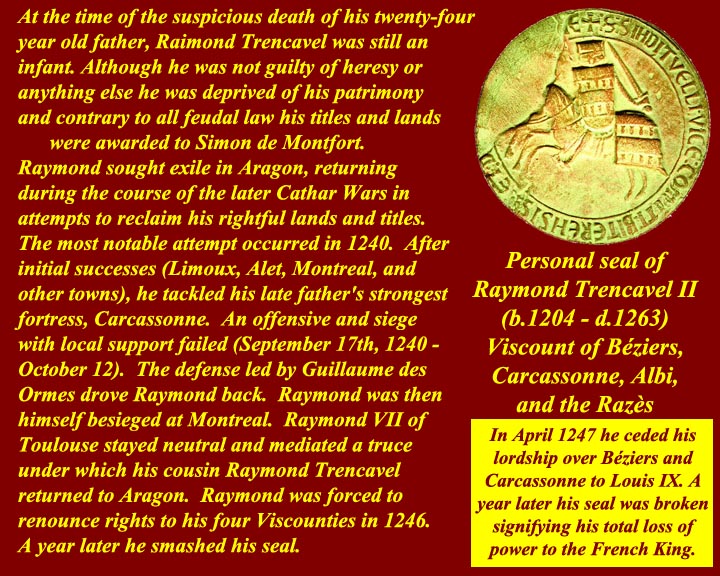
http://www.mmdtkw.org/CRUS0926-RaymondTrencaval2.jpg
Raymond Trencavel II: (1204-126).
Viscount ofCarcassonne. Son of Raymond-Roger. Click here
for more on Raymond
Trencavel II
(http://www.cathar.info/120513b_trencavel.htm).
Raymond Roger: Count of Foix (1188-1223). Click here for
more on Raymond Roger
Roger Bernard II: Count of Foix
(1223-1241). Click here for more on Roger Bernard II
Roger IV: Count of
Foix (1241-1265). Click here for more on Roger IV
Savaric de Mauléon: (
Mauléoun). (1181-1233) Vassal of King John
of England and ally of the Counts of Toulouse.
Click here for more on Savaric de
Mauléon
Count of Comminges: Vassal and ally of the Counts of
Toulouse. Click here for more on Count of
Comminges
Viscount of Béarn: Vassal and ally of the Counts of
Toulouse. Click here for more on Viscount of
Béarn
Esclarmonde of Foix: Parfaite.
Click here for more on Esclarmonde
of Foix
Guilhem Belibaste: (c 1280 - 1323) The last known Cathar Parfait
in the Languedoc, burned at the stake in 1323. Click here for
more on Guilhem
Belibaste
|
|
||
|
|
||
|
|
|
|
|
|
[Click this lie to jump to images of Baltic crusaders and defenders]
From http://en.wikipedia.org/wiki/Northern_Crusades
The Baltic/Northern Crusade
| Northern Crusades | |
| Date | 12th and 13th century |
| Location | Estonia, Latvia, Lithuania, Prussia |
| Belligerents | |
| Crusaders | Pagans |
| Commanders and leaders | |
| Valdemar I of Denmark Valdemar II of Denmark John I of Sweden Albert of Riga Anders Sunesen Caupo of Turaida † Theoderich von Treyden† Volquin† Wenno Wilken von Endorp† Tālivaldis of Tālava† |
Lembitu of
Lehola† Ako of Salaspils† Visvaldis of Jersika Viestards of Tērvete Nameisis of Zemgale† |
From: http://depts.washington.edu/baltic/papers/crusades.htm
The Baltic Crusade
Ruth Williamson
SCAND 344, June
2002
Introduction - Expanding
Frontiers - Crusading Orders - Military Strategy and
Conquest
- The Struggle for Lithuania - Bibliography
Introduction
The Baltic Crusades of the 11th to the early 15th century formed the fulcrum
of the transformation of the Baltic region from rural pagan
farming peasants paying tribute to whatever lord prevailed
over the others to rule them, to the Christianized,
market-oriented, urban foundation of modern Baltic
society. The rise and fall of the knighthood during
this period is indicative of the changes that
occurred. The institution of knighthood represented
the values of medieval Europe, and the incursion of the
knightly orders into the Baltic countries during these
crusades transmitted those values to the Baltic regions
despite the strong resistance of the independent, unchurched
peoples living there. The involvement of north Germans
and Scandinavians in the crusades left critical political
and social imprints and changes that affected the future
path of historical events in the Baltic region that was to
evolve into the countries of Estonia, Latvia and Lithuania.
The Baltic Crusades are a branch
of the Catholic crusading movement that comprised five main
Crusades that occurred between 1096 and 1221. The
Crusades were “armed pilgrimages” (Haverkamp, p. 12) called
and blessed by the Pope, originally to reclaim Jerusalem and
its surrounding territory in the Middle East, both
considered “holy land,” for the Catholic Church. The
enemies in these Crusades were supposed to be non-Christian,
primarily followers of Islam. As the balances of power
shifted in the 12th century, the Eastern Orthodox Church, based in
Constantinople and the seat of the Christian Byzantine
Empire, became a focus of the Crusades as well. As in
the Baltic Crusades, the motivation of the
combatants—primarily knights and princes—was more related to
acquisition of land and power than holiness, although the
granting to Crusaders of eternal salvation by the Pope was a
meaningful incentive. Notably, the success of the
Crusades, as measured by conversion to Catholicism, was
negligible in the Middle East, but high in the Baltic
region, where all but the Lithuanians were converted to
Catholicism by the close of the 13th century.
Expanding
European Frontiers
Turmoil prevailed among 12th century north central Europe’s (present-day
Germany) secular and religious political powers, with
players such as the Holy Roman Emperor, the Pope, assorted
princes and nobles, and bishops vying for territory, power
and revenues. Peasants were struggling to escape the control
of these same players, so incentives were offered to
peasants to settle lands to the east for the benefit of a
particular player’s interests, and the incentive usually
included relief from the obligations of serfdom. To
make up the lost revenues, cities and commercial enterprises
were taxed instead. This structure was not the norm in
medieval Europe, which was dominated by the feudal system
that gave the balance of power to landed nobles under their
demesne powers.
East of north central Europe is,
of course, the Baltic region. The traditional peasant,
farming and raiding lifestyle of Baltic peoples was ended
when central European societies’ need for more land grew
into a need for the products and natural resources available
in the Baltic, attracting professional traders who then
wanted some kind of protection from the security risks to
life and property of trading in the remote northeastern
territory. At the same time, the Catholic Church was
interested in preventing the Russian Orthodox Church from
making inroads any further west into the Baltic lands, and
in converting all Orthodox Christians to the one and true
Catholic Church and re-uniting all of Christendom.
Thus the 12th century saw a convergence of the goals of the
Catholic Church and the secular commercial interests to
expand the frontiers of medieval European civilization into
the Baltic lands for political and economic reasons.
Meinhard, an Augustinian monk
from Holstein, accompanied some merchants up the Dauvaga
River in the late 12th century on a mission to begin the attempt to
convert the people of Livoniato Christianity, establishing
the first church building and the first churched community
of believers. Building on Meinhard’s foundation, his
successor Bishop Berthold established a crusading force to
more aggressively convert the local populace in 1198.
This effort coincided with the declaration of the Fourth
Crusade by Pope Innocent III and is considered the beginning
of the Baltic Crusade. The next bishop, Albert,
established the knightly crusading order known as the
Swordbrothers in 1202, obtained papal blessing of an
official crusade in 1204, and by 1208 had forcibly converted
the Kur and Lett peoples to Christianity.
Concurrently, after Bishop Albert established the city of
Riga in 1201 its growth was fed by the economic activity
generated by the Crusades and Riga attracted merchants
looking for a stable base from which to trade in the Baltic
region. Albert was a strong leader who managed to
placate the competing interests of the Pope and the Holy
Roman Emperor and to fend off a Danish take-over move before
his death in 1229.
The
Crusading Orders
The Christian military orders
emerged around 1120, after the First Crusade to the Holy
Land, evolving from the early form of charitable religious
orders doing good in the Holy Land to become a blend of
military and religious disciplines embodied in a special
type of knight, a religious knight. Pope Urban II, in
calling the First Crusade, established a new Christian
philosophy, saying that it was possible to combine warfare
and religious life for “…to lay down one’s life for one’s
brothers is a sign of love.” (Forey, p.12). Suceeding
popes relied on this new philosophy to recruit both
short-term crusading forces from the upper classes as well
as the permanent members of the various Christian military
orders. The first orders were called The Templars and
The Hospitallers, for reasons related to their original
functions. The Teutonic Order grew out of a German
order that ran a hospital in Acre, near Jerusalem, in 1193,
and became established in central Europe by invitation of
the Hungarian king in 1211. In contrast, the Order of
the Swordbrothers was specifically founded to provide a
permanent military presence in the Baltics to reinforce the
“missionary work” of converting of the population by force
without the necessity of relying on volunteer recruits.
While the missionary monks and
bishops introduced Catholicism into the Baltics, it was the
ascendency of the knightly crusading orders, first the
Swordbrothers and then the Livonian Order of the Teutonic
Knights, that defined the Baltic Crusades.
As with the other orders, the
Swordbrothers were an order of professional military men who
also took vows of devotion to Christ to live a monastic life
and fight against the unbelievers. Their ranks were
recruited for the most part from the non-landed,
administrative class of the lower nobility who also composed
the ministerial staff of medieval German princes. The
Order itself was broken into classes of knight, priests and
several classes of servants who performed a wide range of
essential duties. The Swordbrothers were led by their
master, who was elected from the ranks and held the position
for life. While Bishop Albert and the other
missionaries in the Baltic benefited from the presence of
the Order in its formative years, because the Swordbrothers
owed allegiance solely to the Pope in Rome, as the
Swordbrothers gained power and influence, they increasingly
encountered conflict with Bishop Albert.
Military
Strategy and Gradual Conquest
As the Swordbrothers gained
experience in warfare against the Baltic natives they also
learned how to effectively fight in the foreign climate of
Livonia by taking advantage of the ease of travel over ice
and snow in the winter, instead of struggling in the mud the
rest of the year. In addition, they learned to take
advantage of the tribal social structure of the Baltic
native populations, with many small groups intent on
fighting each other for local power. Using this
cultural characteristic the Crusaders conquered one small
tribal group at a time and recruited them to mount attacks
on the next tribe, whom they likely hated. So
gradually the Livs, Semigallians, and Selonians joined the
Letts and the Kurs in succumbing to Catholicism. The
Swordbrothers were also struggling for control of the land
and power that they increasingly thought befit their role in
the Christianizing and civilizing of Livonia. Bishop
Albert was forced to share 1/3 of his small holdings with
the Swordbrothers, and they held out for the right to claim
1/3 of all future lands gained through the crusading
effort. Meanwhile, the Bishop had to constantly
negotiate and hold off masked threats from neighboring
powers such as Russia and Denmark to gain a foothold in his
territory. The Swordbrothers were itching to take on
the Estonians who were fighting to claim the allegiance of
the defeated Letts, and had some successes in smaller
engagements when the Bishop wasn’t available to restrain
them. Ultimately in 1218, through the combination of
Russian aggression, the Swordbrothers’ ascendancy, and
Danish interest in gaining a foothold in Estonia and
fulfilling their Christian crusading vows by joining the
Baltic Crusade, the Baltic Crusade entered Estonia and
brought the Estonian people into the Catholic sphere.
The Chronicle of Henry
of Livonia is a primary source from this period, written
by a priest named Henry who lived in the region from 1205 to
1259 and recorded its history in 1225-6 for his
superiors. His account begins, “Divine Providence, by
the fire of His love….aroused in our modern times the
idolatrous Livonians from the sleep of idolatry and of sin
in the following way.” (Brundage, p. 25).
Henry’s biases reflect the prevailing Catholic view of the
time that the indigenous pagan people were deceitful and
untrustworthy because they were inclined to go through
cycles of adopting and then renouncing Christian beliefs,
according to the dictates of political expediency.
“The most treacherous man…was baptized, as were all the
others….They promised that they would always keep the
Christian law faithfully. This promise, however, they
later violated with their treacherous devices.”
(Brundage, p. 140). For instance, if they were about
to be killed they agreed to be baptized, but once peace
returned they washed their baptism off again in the river.
In the ten years after 1217
Estonia changed hands several times, ending up in 1227 back
under the Swordbrothers’ and Bishop Albert’s
regime. In 1234, veterans of the Jerusalem
crusades were invited to stop the invasion of pagan Prussia
into Christian territories and the Order of the Teutonic
Knights arrived in the Baltic -- a larger, more
traditionally established German-based order than the
Swordbrothers. After the complete defeat of the
Swordbrothers by the Lithuanians at the Battle of Saule in
1236, the remaining Swordbrothers merged into the Order of
the Teutonic Knights, forming the Livonian Order. In
1242 the Russians defeated the Livonian Order in the Battle
of Lake Peipsi, establishing a defined boundary between the
German-speaking Baltic lands and Russia that lasted for
centuries.
The
Struggle for Lithuania
In 1252 the Teutonic Order
captured the Lithuanian city of Klaipeda, cutting off
Lithuania’s only access to the sea (not regained by
Lithuania until the 20th century). In 1253
Duke Mindaugas of Lithuania -- surrounded by knights on
almost every side -- agreed to accept Christianity.
Then all of Lithuania fell into the Christian realm except
Samogitia which refused to recognize Mindaugas as their
leader and continued to fight the Order. When
Mindaugas was assassinated in 1263 by an insider, Lithuanian
reverted to pagan faith and a chaotic time followed .
In 1284 the Teutonic Order succeeded in defeating Prussia,
which disappeared as a distinct tribe, assimilating into the
neighboring societies of Poland, Germany and
Lithuania. Later German conquerors appropriated the
name ‘Prussia’ for themselves.
The Crusaders in the 14th century continued the consolidation of their
hold on the Baltic lands, strengthening their power in
Estonia in 1343 as a result of the peasant rebellion against
Danish rule and the subsequent Danish sale of northern
Estonia to the Teutonic Order for 10,000 marks. Early
in the century Grand Duke Gediminas of Lithuania had
successfully expanded his territory to the south and east
and also prevented Crusaders’ incursion into the land.
But in 1382 Lithuania lost Samogitia and it was ruled by the
Teutonic Knights for almost 30 years. In 1386 Grand
Duke Jogaila of Lithuania preserved his country by marrying
the Polish queen in the Union of Kreva and created the
powerful Lithuanian/Polish state. In this union is
cemented the Christian character of Lithuania.
Finally, in 1410, Lithuania, in a coalition with Russians,
Poles, Tatars and Czechs, defeated the Teutonic Knights in
the Battle of Zalgiris at Tannenberg and Grunwald, ending
the military existence of the Teutonic Knights forever.
Sources
· City Paper. “The Baltic Crusades: A
Chronology,” n.d,. http://www.balticsww.com/Crusaders.htm
(9 April 2002)
· This site is sponsored by a Baltic regional
newspaper called City Paper and is a graphically attractive
timeline of the Baltic Crusades combined with a narrative of
excerpts from The Chronicle of Henry of Livonia and William
Urban’s book The Baltic Crusade. [Apparently
now a dead link -- TKW]
· Brundage, James A. The Chronicle of Henry
of Livonia; A Translation with Introduction and
Notes. Madison: The University of Wisconsin Press,
1961.
This is the
current classic translation of this important primary source
of the early period of the Baltic Crusades into English.
· Christiansen, Eric. The Northern Crusades:
The Baltic and the Catholic Frontier, 1100-1525. Minneapolis: University
of Minnesota Press, 198
As its title
indicates, this book covers over three hundred years of
crusades in the Baltic region of northeastern Europe.
A detailed but concise chronology of the events of the era
is included, as well as a list of the relevant northern
secular and religious rulers of the Baltic, Scandinavia and
Russia. It has a number of excellent, detailed but
easy-to-read maps of the region at various milestone dates
in the period covered. The content appears to
thoroughly cover the secular, political, social and
religious factors issues in northeastern Europe during the
existence of the crusades in the Baltic region.
· Forey, Alan. The Military Orders: From
the Twelfth to the Early Fourteenth Centuries. London: MacMillan
Education Ltd., 1992
The title says
it all—this book is an exhaustive study of the military
orders from the 12th to the 14th centuries.
· Haverkamp, Alfred. Medieval Germany
1056-1273. Translated by Helga Braun and Richard
Mortimer. New York: Oxford University Press, 1988.
The first three chapters of this book provide
dense but useful background information on the political
landscape in the rest of Europepreceeding and concurrent
with the Baltic Crusades, especially the role of the
Catholic Church in the context of the Crusades.
· Ots, Loone. “Estonian Literature,”1998, http://www.ibs.ee/ibs/culture/estonian%5Fliterature/
(6 April 2002)
This site has excerpts and summaries of the
Chronicles, among many other resources on the Baltic world,
from an Estonian point of view. The section on Henry
of Livonia has several interesting links to depictions of
the crusaders, Vikings, and other images.
· Urban, William. “An Historical Overview of
the Crusade to Livonia,” 1995-1999, http://orb.rhodes.edu/encyclop/religion/crusades/cruurban.html
(9 April 2002)
Urban is a prolific writer on Baltic history
subjects and a professor at Monmouth College in
Illinois. This article is a 12-page history with maps
and a good bibliography.
· Urban, William. The Baltic Crusade.
DeKalb: Northern Illinois University Press, 1975.
This book covers the history of the Baltic
crusades for the period 1175-1300 A.D. It is the most
definitive, one-stop source of information on the Baltic
Crusades. It has good maps, genealogical charts for
important royal houses and influential families of the
period, and provides comparative chronologies for the period
of both events in Livonia and Europe, and of the important
leaders of the various countries, religious orders, the Holy
Roman Empire and the prominent family affiliations of the
time.
· Urban, William. “The Sense of Humor Among the
Teutonic Knights of the Thirteenth Century” 1979, http://department.monm.edu/history/urban/articles/humor_of_Teutonic_Knights.htm
(12 April 2002)
This is another Urban article, focusing on
humor in the society of the Teutonic Knights, the knightly
order that was most prevalent in northern Europe in the 13th century and that set the
standard for other medieval knightly orders.
· Urban, William. “Victims of the Baltic
Crusade,” 1998,
http://department.monm.edu/history/urban/articles/VictimsBalticCrusade.htm
(12 April 2002)
This article explores
the application of the modern concept of victimization to
the events of the Baltic Crusade. Because of the
expertise of the author, this article contains more relevant
historical detail than it might appear and has a good
bibliography.
From: https://archive.li/D9hJN
(in left sidebar)
The
Baltic Crusades:
A Chronology
|
|
||
|
·
1180 First attempt to
convert Baltic pagans, led by Bremen-based Meinhard.
·
1184 First Christian
church built in Livonian village of Uexküll
(present-day Ikskile, in Latvia). ·
1186 Meinhard
consecrated as the first Bishop of Uexküll. He
establishes the first permanent Christian entity in
the Baltics. ·
1196 New Bishop of
Uexküll, Berthold assembles the first crusading army
in the Baltics. Serious hostilities between
Christians and pagans begin. A segment of the
Livonian pagans forcibly converted within two years. ·
1199 After the death
of Berthold in battle, Albert becomes Bishop of
Uexküll. He arrives with an army and the Baltic
Crusade begins. ·
1201 Bishop Albert
begins to transform a small Livonian fishing village
into the seat of the Bishopric, Riga. ·
1202 The Livonian
Order-the first standing Christian army in the
Baltics-is formed. ·
1203-04 A chieftain of a
large Livonian tribe, Kauppo, makes a pilgrimage to
Rome to meet with the Pope. The convert and loyal
supporter of the Bishopric impresses the pontiff. He
pledges to help the Crusade, which is led by Albert.
·
1208 The lands known
today as Latvia firmly under the control of Bishop
Albert. Various tribes that today make up Latvians,
including the Letts and Kurs, succumb to
Christianity. Merchants from Germanic lands settle
in Riga and throughout the region. ·
1211 Bishop Albert
lays the cornerstone for the Dome Cathedral in Riga. ·
1217 The Livonian
Order's campaigns into Estonia begin with the taking
of Fellin (Viljandi in Estonia) and the killing of
Estonian tribal leader Lembitu. ·
1218-19 Heeding the call
of assistance from Bishop Albert, Danish forces move
against northern Estonia. After a historic battle
the Danes conquer the village of Lindanäs (modern
day Tallinn). ·
1219-1240 Duke Mindaugas
unites Lithuania. ·
1220 All of Estonia
under the control of either the Livonian Order or
the Danish Crown. ·
1223 Peasants from the
island of Saaremaa lead an uprising that retakes
most of Estonia, except for Tallinn. They are
subjugated again by 1227. ·
1234 Veterans of the
Crusades in the Middle East invited to stop the
invasion by pagan Prussians (a Baltic cousin of the
Lithuanians-the name was later adopted by their
Germanic conquerors) into Christian lands. The group
establishes itself as the Teutonic Knights. ·
1236 After a
disastrous defeat by Lithuanians at the Battle of
Saule, the Livonian Order collapses, becoming merely
a northern branch of the Teutonic Knights. ·
1242 The Russian
forces, led by Prince Alexander
Nevsky, defeat the crusaders in the historic
battle on the frozen Lake Peipsi. A frontier between
the German Order and Russia remains at that point
for many centuries. ·
1252 The Teutonic
Knights push ahead and take the Lithuanian city of
Klaipeda from local Baltic tribes, cutting off
Lithuania's access to the Baltic Sea until the
1920s. The city is renamed Memel. ·
1253 Squeezed by the
Knights from almost all sides, Mindaugas sues for
peace and agrees to accept Christianity. Mindaugas
is crowned King with the Pope's assent and is
considered an equal to all kings in Europe.
Samogitia (Lithuania's lowlands) rejects the
Mindaugas deal and continues its war against the
Christians. ·
1255 The stronghold of
Königsberg is built by the Teutonic Knights.
Centuries later it becomes the force which unites
Germany. It's now Kaliningrad. ·
1263 King Mindaugas is
murdered by internal enemies and chaos resumes. ·
1284 Teutonic Knights
fully subjugate the Prussians, who eventually become
extinct as a people and are assimilated by Germans,
Poles and Lithuanians. The German conquerors adopt
the name Prussians for themselves. ·
1316 Accession of
Lithuanian Grand Duke Gediminas, who continues to
enlarge Lithuanian territory to the Russian lands
east and south of Lithuania. Germanic forces are
held from taking Lithuanian territory. ·
1343-46 Estonian peasants
lead an uprising against the Danes. Though the
revolt, known as the St. George's Night uprising, is
repelled, the Danes sell their lands in the northern
part of Estonia to the Livonian Order for 10,000
marks. ·
1382 Lithuania is
forced to give up Samogitia-a holdout from Christian
conversion to the Germanic crusaders. The Teutonic
Knights rule until 1409. ·
1386 Strains of wars
hit Lithuania, and Grand Duke Jogaila contrives a
plan to secure the region. He marries Polish Queen
Jadwiga and the Union of Kreva creates a monarchical
link between the two states. Lithuania-Poland
becomes the most powerful entity in the region for
centuries. This also entails Lithuania to accept
Christianity. ·
1410 Lithuanian
forces, led by Grand Duke Vytautas with a combined
army of Russians, Tatars, Poles and Czechs, defeat
the Teutonic Knights at a historic battle near the
villages of Grünwald and Tannenberg (in present-day
Poland). The battle is named Zalgiris by the
Lithuanians. The loss ends the military threat of
the Teutonic Knights for good. The Order has never
been disbanded and still exists today as a
charitable organization. —compiled by Mel Huang |
|
|
| |
|
|
From: https://archive.li/D9hJN
Excerpts from The Baltic
Crusade by William L. Urban, Lithuanian
Research and Study Center, Chicago, Illinois, 1994.
—CITY PAPER-The Baltic States
The
Crusaders
At
the turn of the 13th century, after trying and failing to
conquer the Holy Land, crusading Christians looked around
for easier pickings. They looked towards the last
unconquered piece of pagan real estate in Europe—the eastern
coast of the Baltic Sea.
The ancient Chronicles
of Henry of Livonia (1227) provides a rich,
descriptive account of the dramatic events during those
crucial years when German knights completed their
subjugation of Livonia—the name at the time for Latvia and
Estonia. (see Chronology
sidebar).
The
following are excerpts from those chronicles:
The German knights established their first
foothold in Riga in 1201, and over the next decades
imposed their rule over most of the rest of the region.
With Riga firmly in their hands, much of the crusader
activity focused on Estonian tribes to the north who
fiercely resisted the attacks from Riga. Often Estonian
tribes themselves sacked Christian settlements. Naval
battles were common among the seafaring crusaders and
Estonians.
“The knights labored long with their companions in the struggle with the rough sea and at length came to a region of Estonia. The Estonians, wishing to take their lives and possessions, attacked them with ten pirate ships and twelve other ships. God preserved His people, however. They suffered neither adversity nor sorrow from the enemy; rather, one of the pirate ships was broken to pieces by the Christians, some of the pagans were killed, and others miserably drowned in the sea. They hooked another pirate ship with an iron hook and tried to drag it toward themselves. The pagans, however, wishing rather to be endangered in the sea than to be killed by the Christians, jumped from the ship one by one. While they fell into the danger of death, the other ships departed and escaped.”
Conflicts among the native Baltic tribes
themselves were also common. The crusaders often took
advantage of this to further their cause, to divide and
conquer. The Latvian-based Semgalls allied themselves with
the German knights and frequently joined in attacks
against the Lithuanians, who staged attacks as far afield
as Estonia.
"In the seventh year 1205, about lent, when these tribes are more accustomed to engage in war, the Lithuanians moved against Estonia with a force of almost two thousand men. They descended along the Daugava River and passed by the city. After a few days, Viesturs, a noble of the Semgalls, hearing about the Lithuanian expedition, came hurriedly to Riga and spoke in admonition to the Germans for having permitted the enemy to cross their boundaries peacefully. Although they did not wish, because of the weakness of their forces, to fight before their ruler Bishop Albert's return, Viesturs, being a warlike man, excited them to battle and promised to bring a great many Semgalls to their aid.... When the army arrived, hostages were delivered into the hands of the Germans and, their loyalty thus demonstrated, the Semgalls obtained both help and friendship. The Germans went out to the army in a high place where they and the Semgalls awaited the return of the Lithuanians.... At length the Lithuanians returned with numerous captives and indescribable booty in flocks and horses, entered Livonia, and proceeded gradually from village to village. At last they turned aside to the fort of Kauppo and trusting the peace of the Livonians, spent the night among them. The scouts of the Germans and Semgalls inquired discreetly about their return and announced this to their own army. When they heard these reports, the whole army rejoiced and all prepared in rivalry for the fight. The Lithuanians came with all their loot and captives, who numbered more than a thousand, divided their army into two parts, placed the captives in the middle, and because of excessive depth of snow, marches single file over one path. But as soon as the first of these discovered the footprints of those who had gone before, they stopped, suspecting an ambush. Thus the last in line overtook the first and all were collected in one formation with the captives. When the Semgalls saw their great multitude, many of them trembled and, not daring to fight, wished to seek safer places. Thereupon certain of the Germans approached the knight Conrad and begged instantly that they go first into battle with the enemies of Christ. They asserted that it was better to go to death gloriously for Christ than, to the confusion of their tribe, to take flight dishonorably. Conrad, with his horse and himself well-armored, like a knight, attacked the Lithuanians with the few Germans who were on hand.”
After a few years, the Estonian tribes were
losing ground to the crusaders. Eventually, the German
crusaders staged an important assault on the invasion of
Fellin, now Viljandi, which was the stronghold of Estonian
tribes.
“The pagans would listen to nothing about God or the Christian name. They rather threatened war and donned the arms of the Germans which they had seized at the gate of the fort during the first engagement. On the heights of the fort they gloried in these arms, they prepared themselves for war, and with their shouting they jeered and mocked at the army. But the Letts, allies of the Germans, having taken captives earlier and slaughtered them, threw them into the moat and threatened to do the same to those who were in the fort. The archers, meanwhile, killed many men and drove them all back to the stronghold, while other men built a tower. The Letts went up to the tower, killed many men on the battlements with arrows and spears, wounded many, and for five days a very great battle raged. The Estonians strove to burn down the first pile of wood by casting a great deal of fire from the fort onto the carts. The Livonians and Letts threw ice and snow and put it out. Arnold, a German crusader, labored there day and night. At last he was hit by a stone and crossed over into the brotherhood of the martyrs. He was an extremely religious man and was always praying. He found, as we hope, that for which he prayed. The Germans built a machine and, by hurling stones night and day, they broke down the fortified places and killed men and innumerable beasts of burden in the fort. Since the Estonians had never seen such things, they had not strengthened their houses against the force of such missiles. The Germans followed in arms, removed the planks and, on the inside, found another wall which they could not get through. The men of the fort gathered up above and forced the Germans back by throwing stones and logs. The Germans came down, brought flames to the fort and set it on fire On the next day, when the burning was over, they replaced everything, and the survivors nerved themselves once again for the defense. There were, however, many corpses of the slain in the fort, there was a shortage of water, and nearly everyone was wounded, so that now they gave out. On the sixth day the Germans said: "Do you still resist and refuse to acknowledge our Creator?" To this they replied: "We acknowledge your God to be greater than our gods. By overcoming us, He has inclined our hearts to worship Him. We beg, therefore, that you spare us and mercifully impose the yoke of Christianity upon us as you have upon the Livonians and Letts.”
Henry of Livonia documents another battle
against the Estonians. The excerpt demonstrates the role
of the Livonian Kauppo, who supported the Germans and
who, to this day, is still remembered by Estonians and
Latvians as one of the greatest traitors in their
history.
“The crusaders donned their weapons, put the trappings on their horses, and with their infantry, the Livonians, and their whole company crossed the Aa river, went on through the night, and approached the pagans. They arranged the army and instructed it for the war. The infantry they sent ahead on the major road. The knights, however, followed on the road which leads to the right. The infantry marched cautiously and in orderly fashion. When morning broke they came down from the mountain and saw the fort and the pagan army, and the valley was between them. Immediately they beat joyfully upon their drum and enlivened the spirits of their men with their musical instruments and their song. They called down God's mercy upon them and swiftly hurried towards the pagans. After crossing a little stream they halted for a moment to collect themselves in a group. When the pagans saw them, they were terrified by the unmistakable prospect. They ran, got their shields; some of them rushed to the horses, others leaped over the barricade, and they all assembled in one group. They troubled the air with their shouts and came out in a great multitude to meet the Christians, throwing a shower of spears upon them. The Christians caught the spears with their shields, and when the pagans had run out of spears, the Christians drew their swords, marched closer and commenced the fight. The wounded fell and the pagans fought manfully. The knights saw the strength of the pagans and suddenly charged through the center of the enemy. The trappings of the horses threw terror into the enemy. Many of them fell to the ground, the others turned to flight, and the Christians pursued those who fled. They caught them and killed them on the road and in the fields. The Livonians from the fort went out and met the fleeing pagans. They scattered them on the road and enveloped them. Then they slaughtered them, up to the German lines. They pursued the Estonians so that few of them escaped and the Germans even killed some of the Livonians as if they were Estonians.”
This
defeat opened up an avenue for the crusaders to march
across Estonia and to eventually force the conversion of
all Estonians. It was a devastating blow and soon all of
the Estonians were under the subjugation of either the
Germans or the Danes, who grabbed northern Estonia.
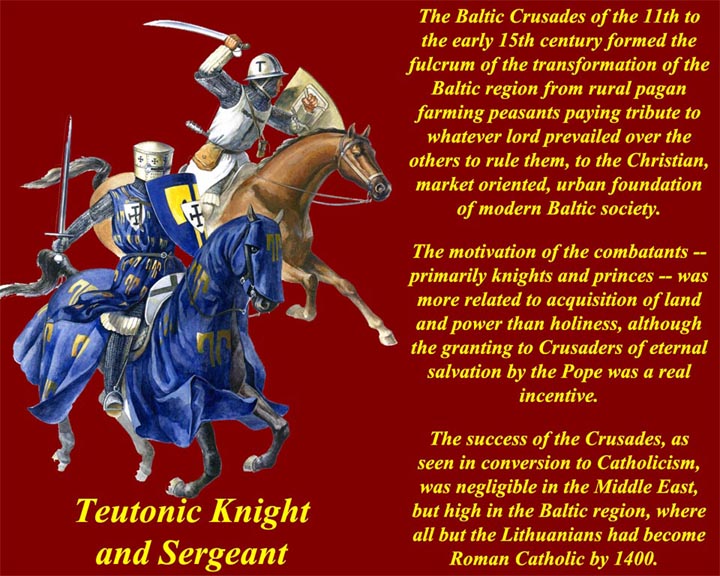
http://www.mmdtkw.org/CRUS0929-BalticCrusades.jpg
The Baltic Crusades transformed the region from a rural tribute paying area to the Christian, market oriented, urban society.
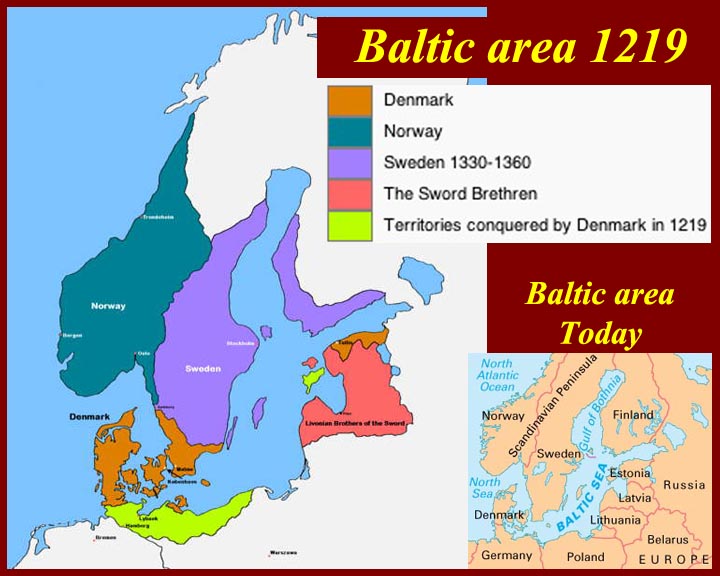
http://www.mmdtkw.org/CRUS0930-BalticArea1219.jpg
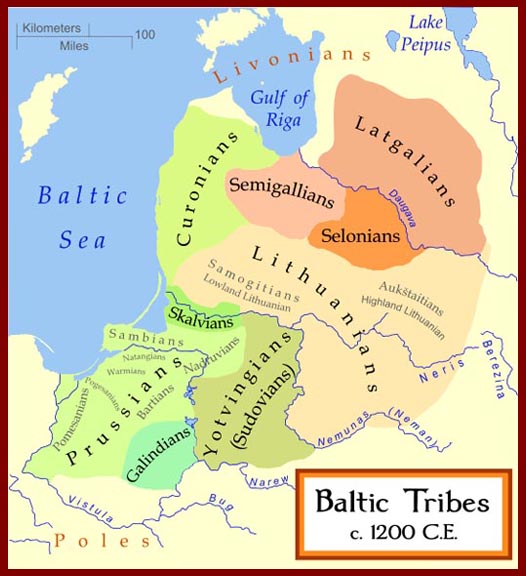
http://www.mmdtkw.org/CRUS0931-BalticTribes1200.jpg
Before the Crusader conquests, the southern and eastern Baltic indigenes were pagan, mostly animist members of localized tribal groups. The groups were led by warlord families which defended territories usually within natural boundaries. Within a few years they had been reorganized by already established neighbors.
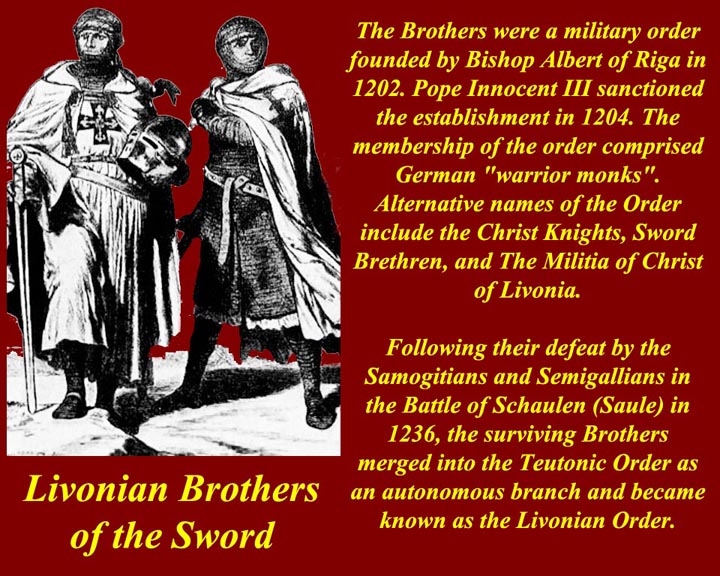
http://www.mmdtkw.org/CRUS0932-LivoniaKnight.jpg
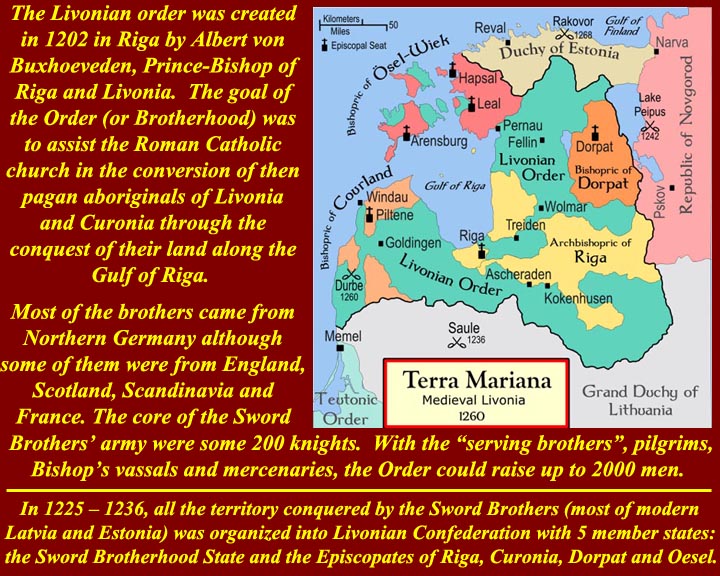
http://www.mmdtkw.org/CRUS0933-Livonia_1260.jpg
The "Sword Brethren" were organized with the specific purpose of Christianizing the Livs (from which the area name Livonia was derived). Certainly the founders of the Brethren had religious motivations, but the fighters they brought on board may have had other more secular things in mind.
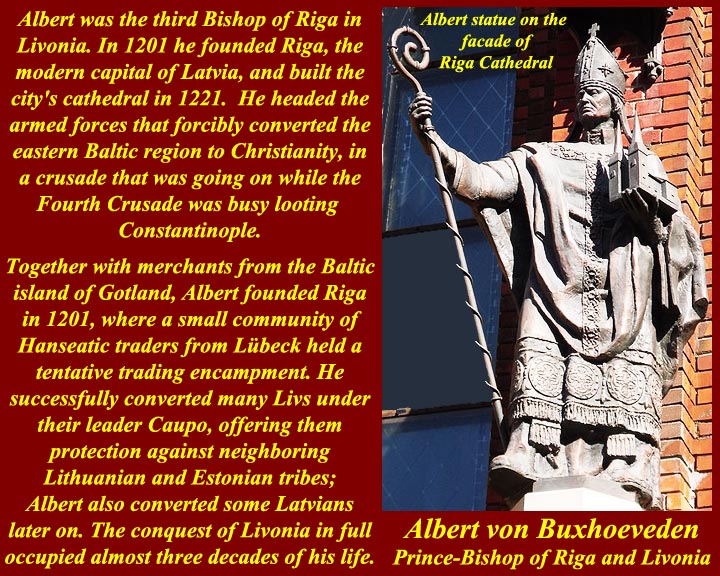
http://www.mmdtkw.org/CRUS0934-AlbertOfRiga.jpg
At the beginning of 1200 he started the conquest and Christianization of the Baltics. He had the support of the German King Phillip and the Pope Innocent III. A fleet of 23 vessels brought him with more than 1500 crusaders to the Baltic shore. Together with merchants from Gotland he founded 1201 Riga (today the capital from Latvia). In 1202 he created the Order of the Sword Brothers. In 1207, Phillip created him Prince of the Holy Roman Empire, and he received Livonia as a fief. In 1215 he started to built the cathedral of Riga. It took more than 27 years to realize the conquest of Livonia and Estonia.
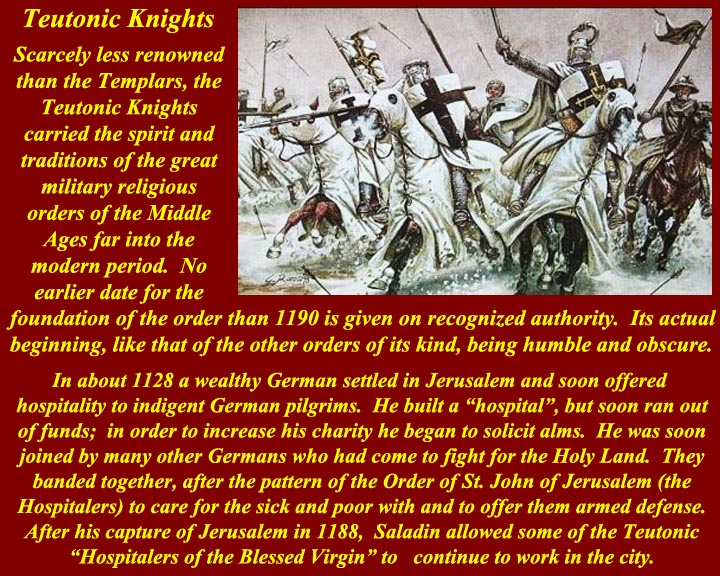
http://www.mmdtkw.org/CRUS0935-TeutonicKnights.jpg
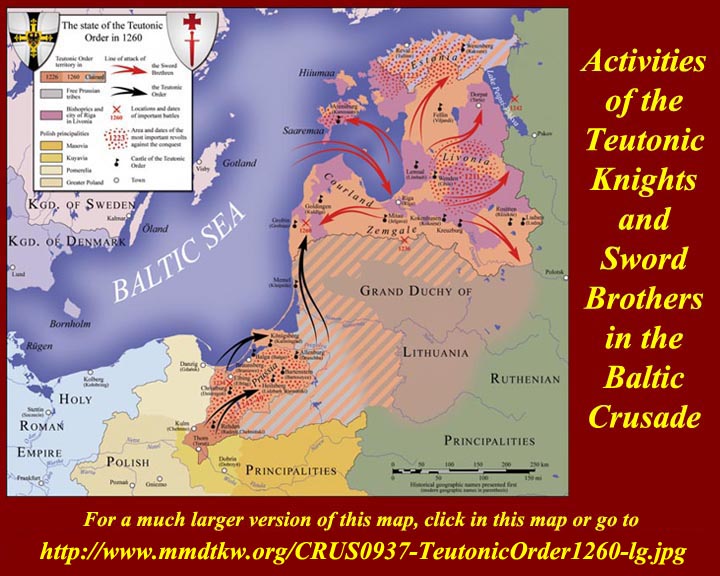
http://www.mmdtkw.org/CRUS0937-TeutonicOrder1260-lg.jpg
The Teutonic Knights absorbed the Livonian Sword brothers and together they were the shock troops of the Baltic Crusades. In all, there were probably only 200 or so mounted Teutonic Knights, but they had with them almost 2000 associated forces and the often moved in concert with troops from neighboring countries.
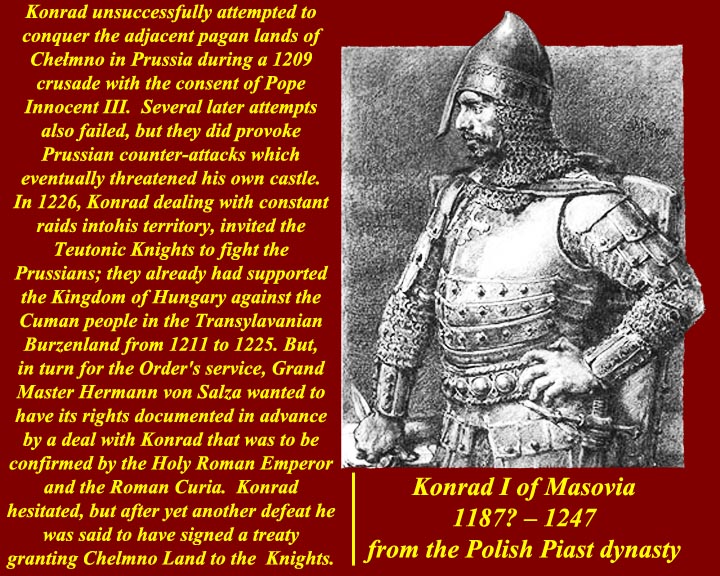
http://www.mmdtkw.org/CRUS0938-KonradMasovia.jpg
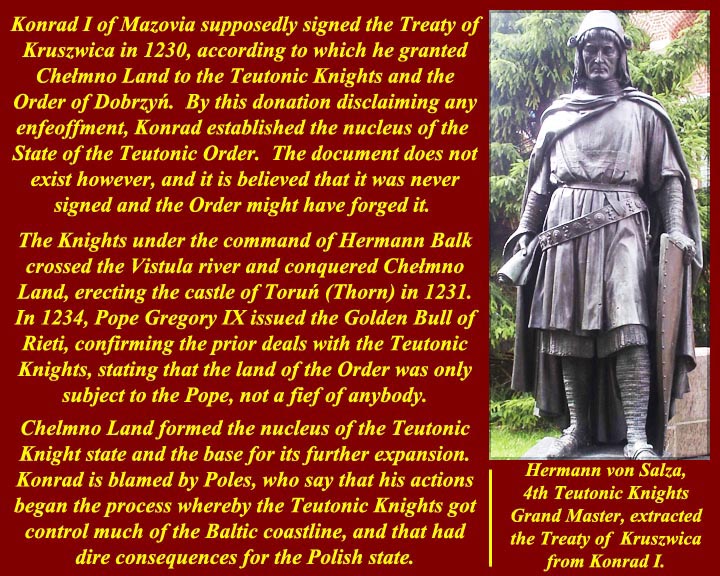
http://www.mmdtkw.org/CRUS0939-HermannVonSalza.jpg
Konrad of Masovia was the over-ambitious leader of the polish state that bordered Prussia. He tried several times to take Prussian Chelmno Land, but only succeeded in provoking devastating counter attacks that he was not able to fend off. Eventually, he contacted the Teutonic Knights who had previously been hired by the Hungarians. The Knights had been expelled from Hungary after they told the Hungarian king that their first allegiance was to the Pope. Not wanting a repeat expulsion after helping Konrad, Hermann von Salza, the 4th Grand Master of the Knights asked for a written agreement outlining their rights. Konrad demurred, but after yet another defeat, he was said to have signed the Treaty of Kruszwica, which ostensibly gave all the land that they would conquer to the Knights. The document has never been found, and that has led historians to conclude that it was a later forgery. Konrad is still vilified by the Poles for having gotten the Teutonic Knights involved in the Baltic area.
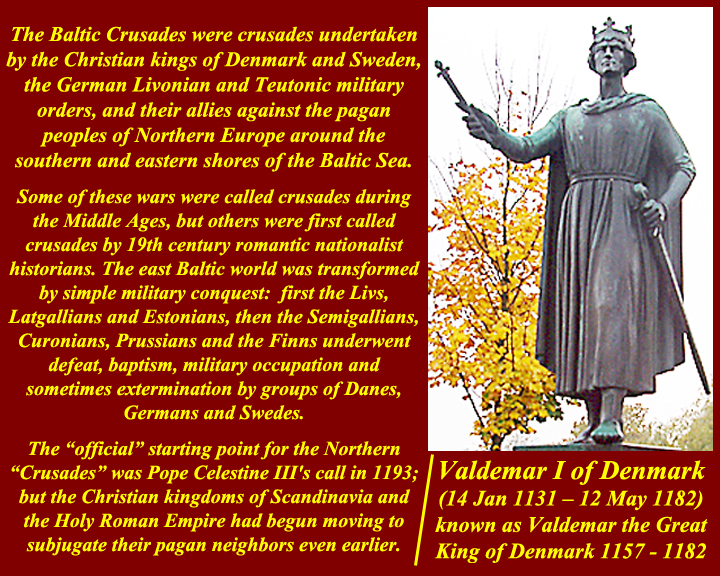
http://www.mmdtkw.org/CRUS0940-ValdemarIDenmmark.jpg
The Kings of Denmark and Sweden undertook "crusades" against neighboring pagan peoples. The word crusades is in quotation marks because the motives of the Kings was clearly just acquisition of neighboring lands. There were also northern "crusades" into Russia without even the excuse of Christianization; the Russians were already Christian (but of the the Orthodox rather than of the Roman Catholic variety favored by the Danes and Swedes.
